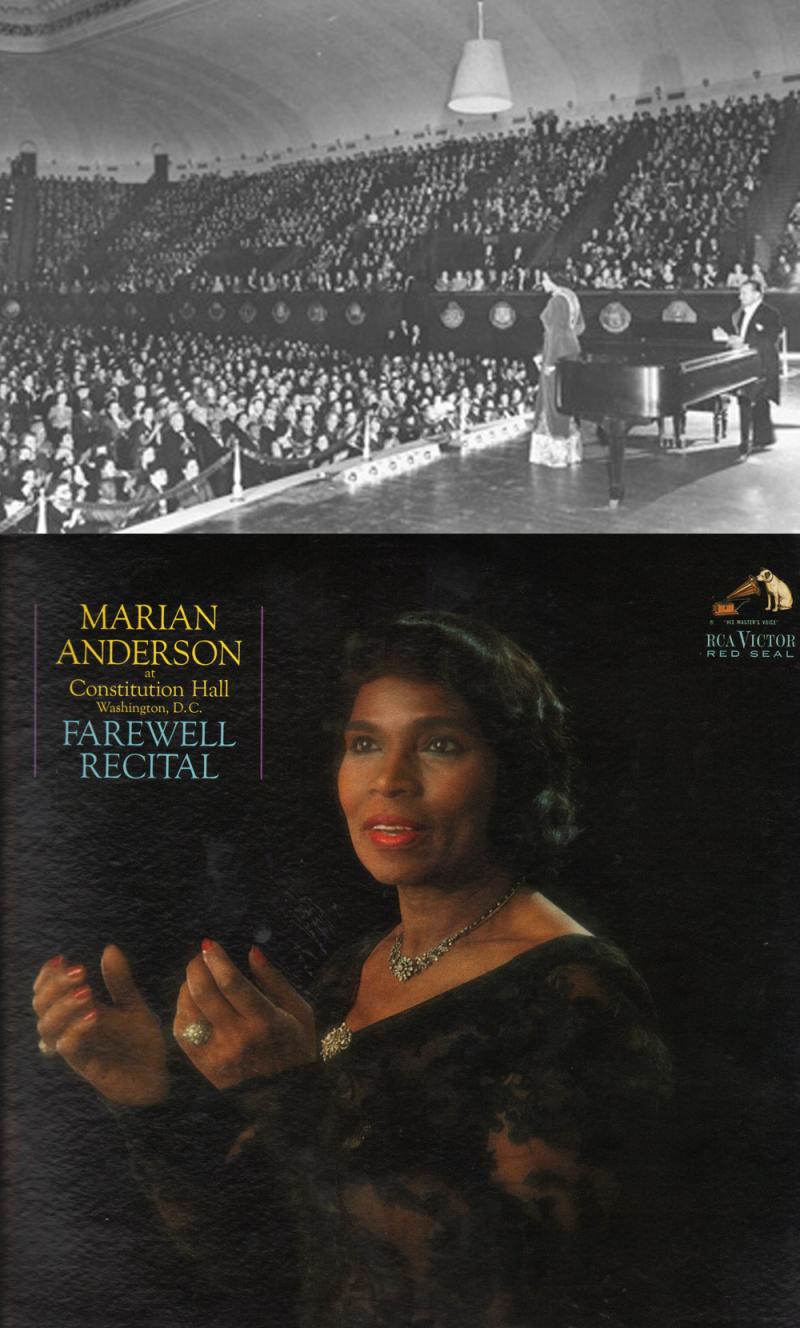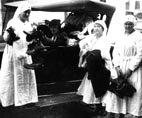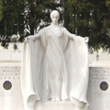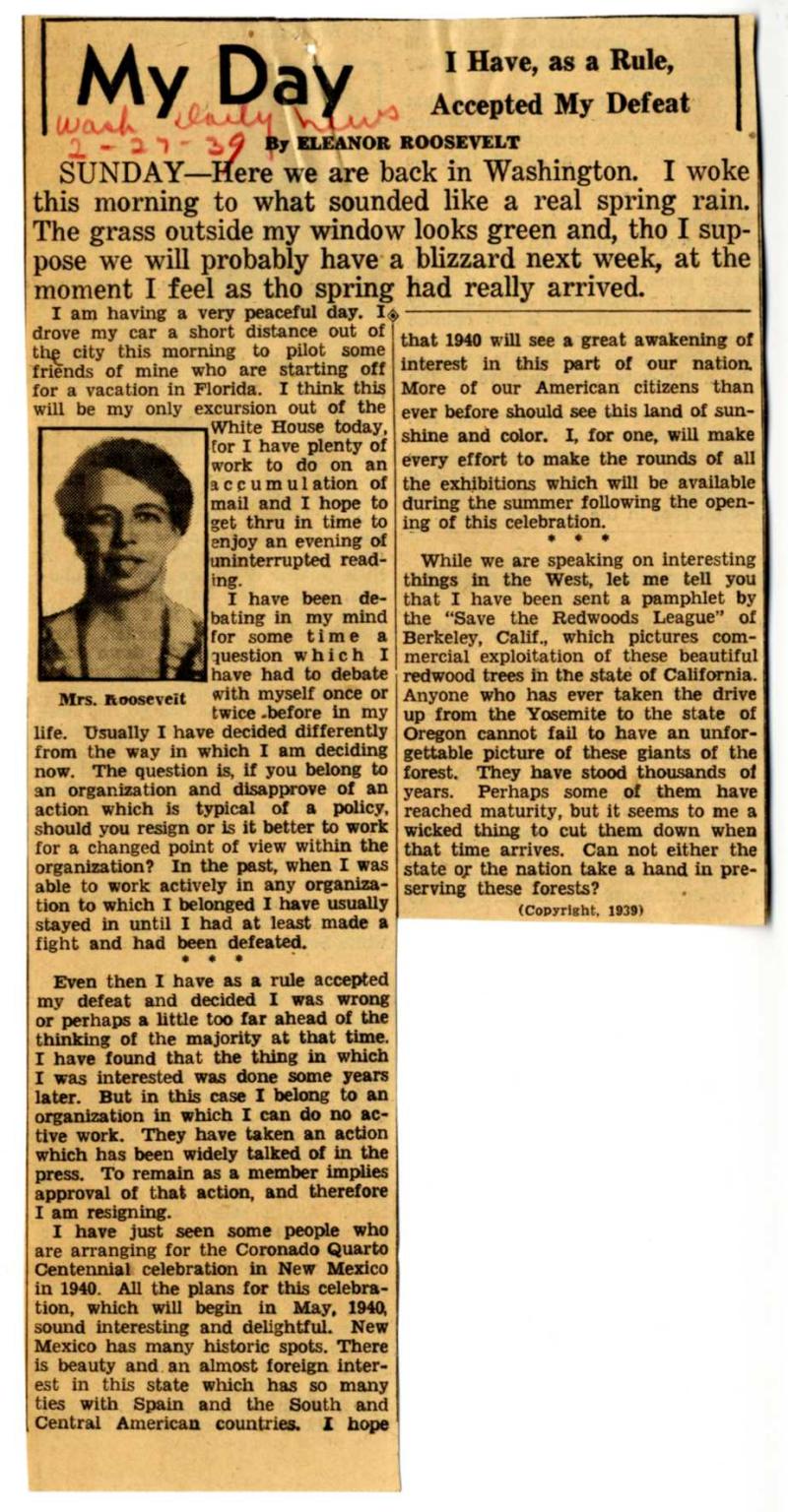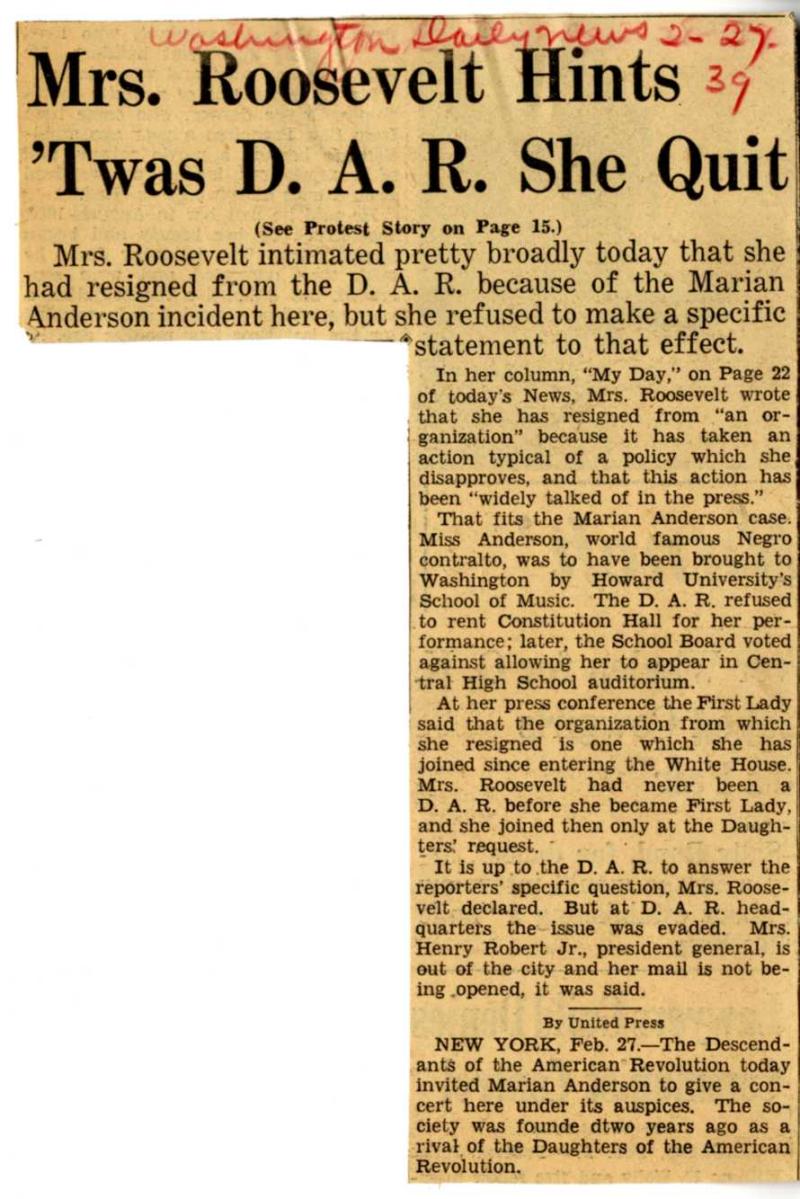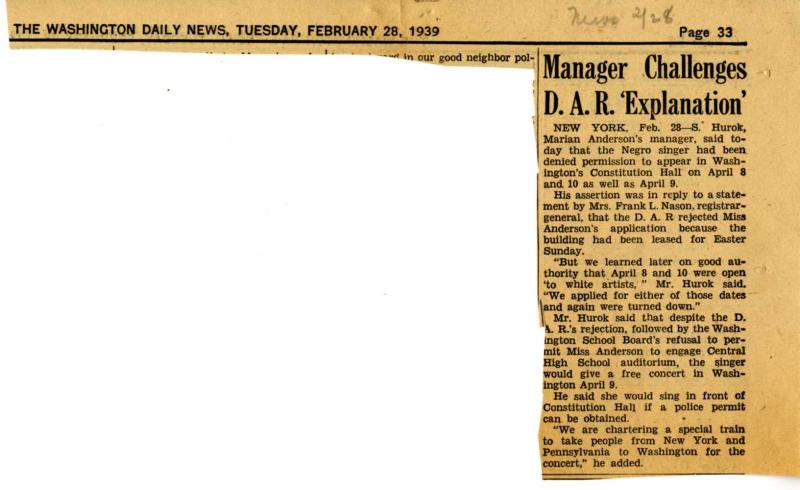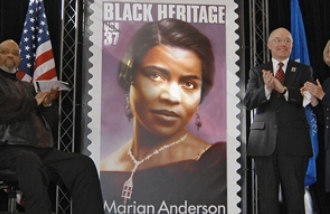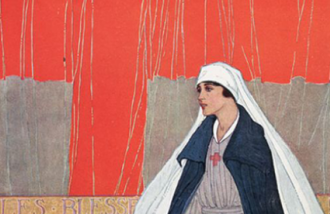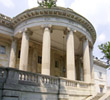In commemoration of the 80th anniversary of Marian Anderson’s historic Lincoln Memorial concert, the DAR launched a project to create a subject guide on documents related to Marian Anderson found within the NSDAR Archives. This online gallery features a sampling of these documents, including new primary source documents that were uncovered during the processing of a 2016 NSDAR Archives’ acquisition, the Sarah Robert Papers (DAR President General from 1938-1941). The archival project is ongoing, but the NSDAR Archives Marian Anderson Resource Guide can be accessed on the Marian Anderson Resources page.
This online exhibit provides a glimpse into some of the materials found within the DAR’s various collections. The featured documents have been organized based upon the general timeline of events related to the DAR’s refusal of Marian Anderson to perform in Constitution Hall, an action which ultimately led to the historic concert on the steps of the Lincoln Memorial on April 9, 1939.
For more information about the launch of the archival project, please visit: www.dar.org/MarianAndersonArchivalProject. To learn more about how the DAR celebrates the life and legacy of Marian Anderson, visit www.dar.org/MarianAnderson.
Marian Anderson was one of the most celebrated American singers of the 20th century, touring all over the world from the 1930s through the 1960s. In 1939, when promoters were attempting to find her a suitable venue in Washington, D.C. capable of holding her expanding audience, they approached management at DAR Constitution Hall, the largest concert hall in Washington, D.C. Their request for a concert on April 9 was denied, reportedly due to a previous booking on the same date by the National Symphony Orchestra. While it was true that there was another booking on April 9, the management also gave another reason for Marian Anderson’s rejection. Namely, there was a policy in place at Constitution Hall at that time which allowed only white artists to perform in the auditorium.
A subsequent request was made to the District of Columbia School Board for use of the second largest venue in the District, the Central High School auditorium, which was a whites-only school. The request was ultimately denied as well, based upon a decision made by the Washington School Board, who maintained their stance on segregation.
These denials prompted a great deal of media attention, climactically resulting in the Secretary of the Interior, Harold Ickes, to arrange for Marian Anderson to perform in the first open-air concert at the Lincoln Memorial. A crowd of more than 75,000 people attended the Easter Sunday concert on April 9, 1939.
Prompting discussion across the country about racial discrimination, Marian Anderson’s Lincoln Memorial concert and the circumstances surrounding it became an important catalyst for change not only within the DAR, but throughout the nation. The following documents are a small portion of the primary source material surrounding this historic event found within the NSDAR Archives, focusing primarily on communications surrounding the events of the concert dating from January to April 1939.
For additional educational resources, as well as more information on how Today’s DAR celebrates the life and legacy of Marian Anderson, please visit: www.dar.org/MarianAnderson.
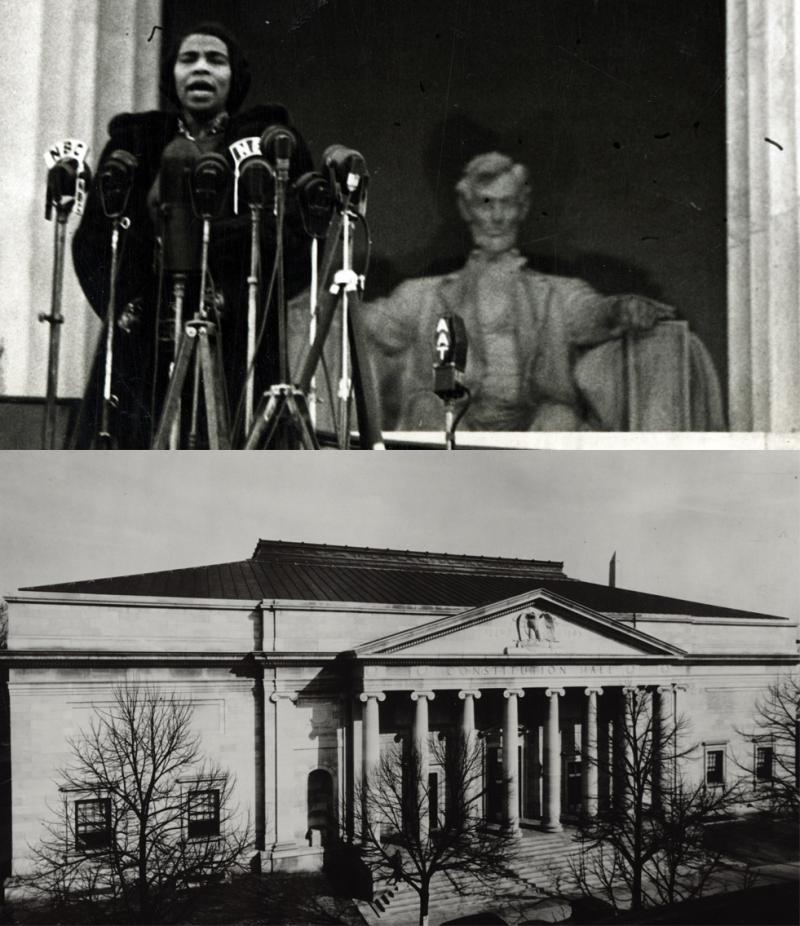
On January 6, 1939, Charles Cohen, Chairman of the Howard University Concert Series, approached Fred Hand, Managing Director of DAR Constitution Hall, with a request for an April 9 booking for Marian Anderson. Hand informed Cohen that the National Symphony Orchestra had already reserved the Hall for Easter Sunday. He also reminded Cohen that a long-standing policy prohibited black artists from performing at Constitution Hall.
Shown: Lease Agreement contract for Constitution Hall between NSDAR and The National Symphony Orchestra Association, dated March 17, 1938, for their 1938-1939 concert season and schedule of events booked for April 1939.
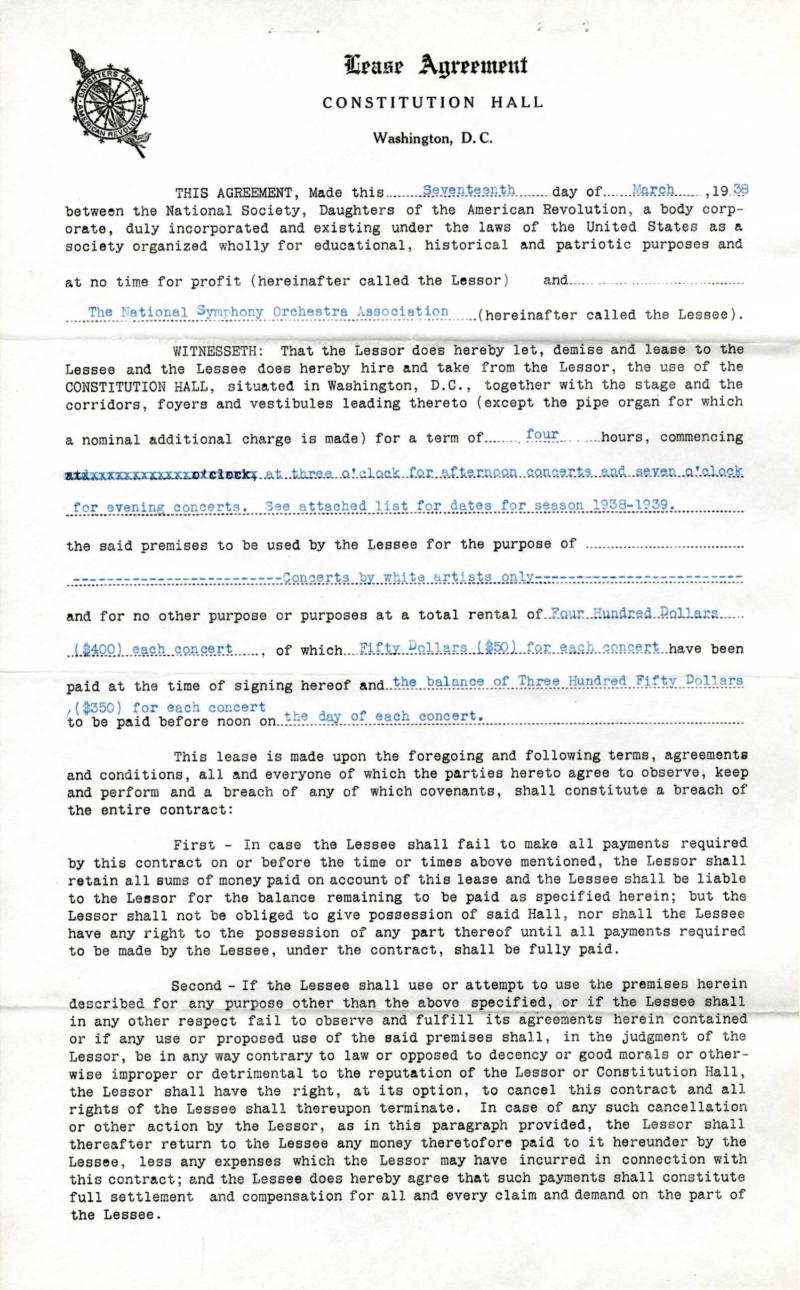
January 13,1939, Washington Times- Herald, Letters to the Editor, “Barred By Race” by V.D. Johnston
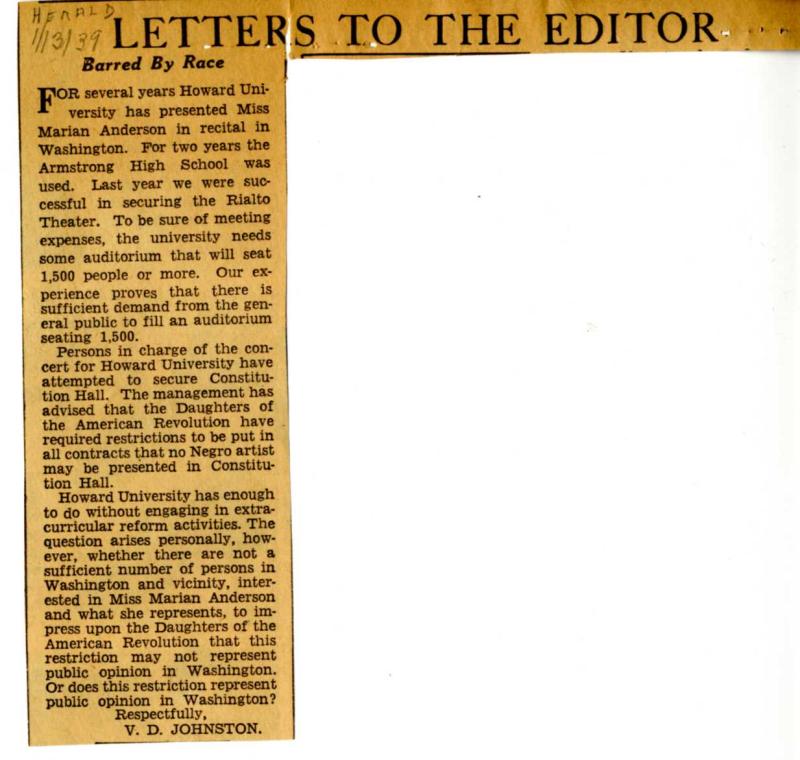
January 15, 1939, Washington Times-Herald editorial.

January 27, 1939, letter from Sol Hurok, Marian Anderson’s manager, to DAR President General Sarah Robert.
February 3, 1939, facsimile of reply letter from Sarah Robert to Sol Hurok.
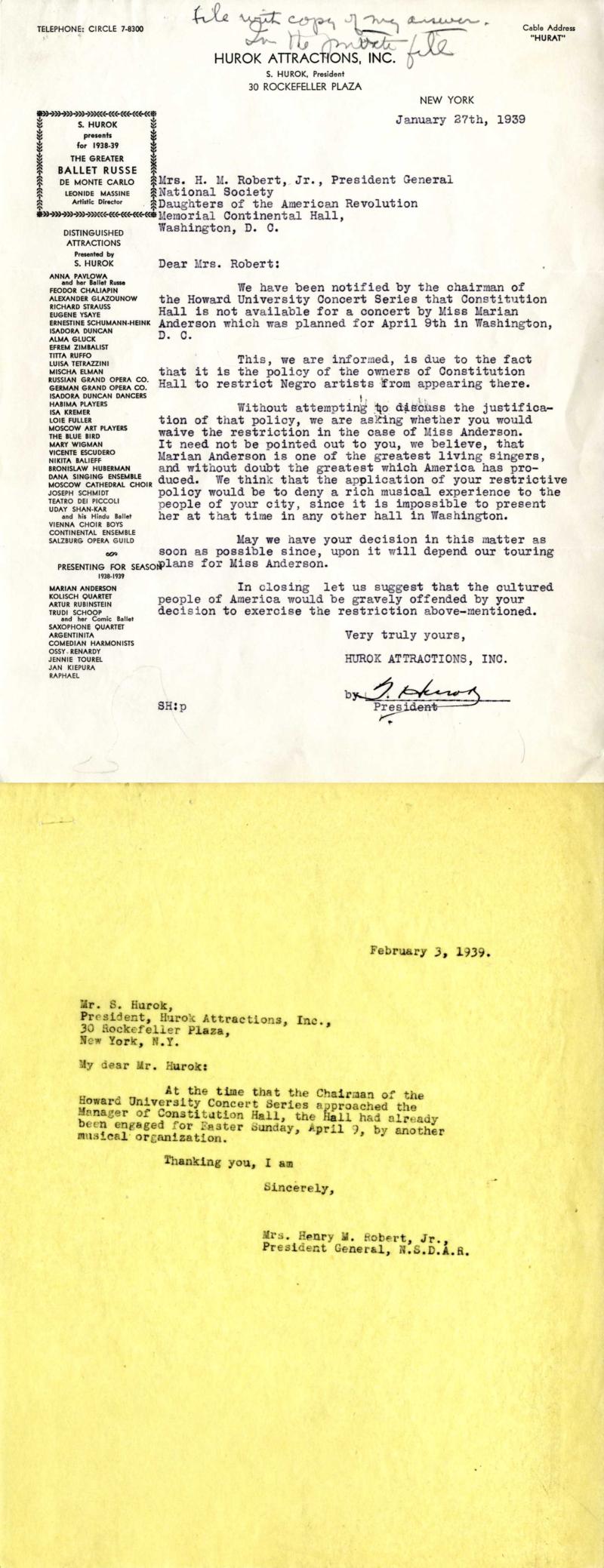
January 30, 1939, letter from Harold Ickes, Secretary of the Interior, to DAR President General Sarah Robert.
February 3, 1939, facsimile reply letter from Sarah Robert to Harold Ickes.
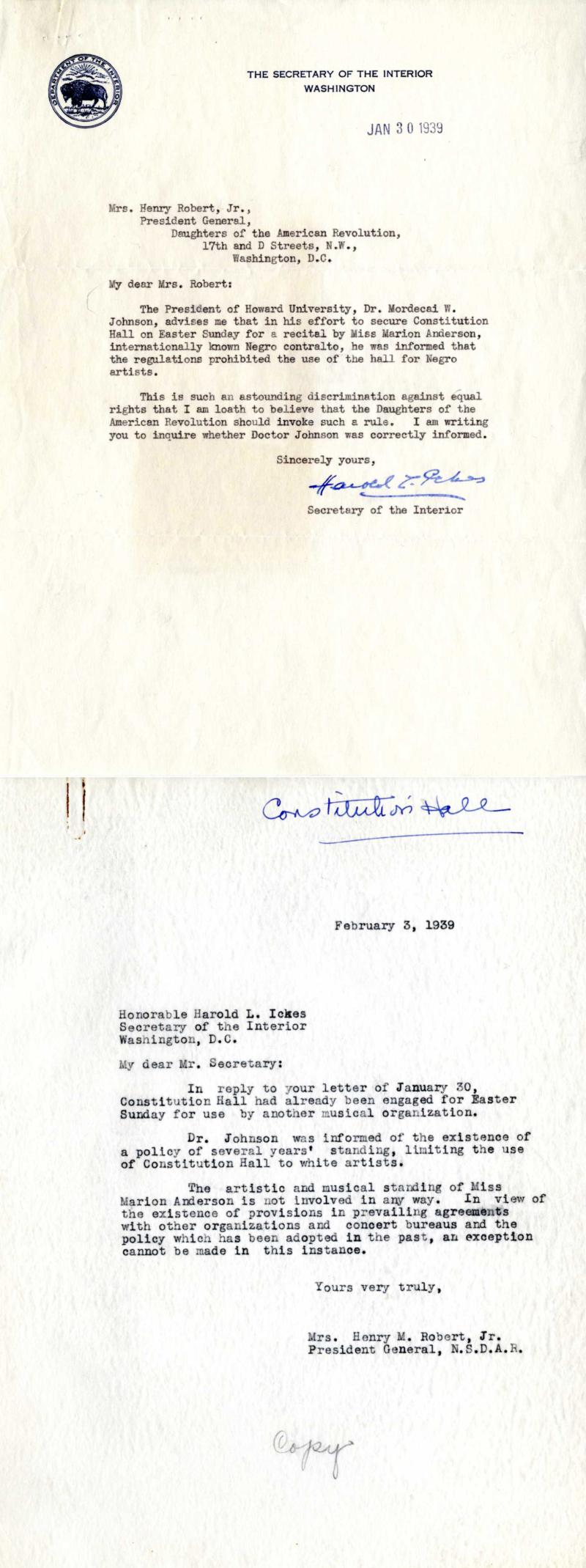
“Constitution Hall” by Fred E. Hand, Managing Director of Constitution Hall, circa 1939. Likely a letter of recommendation to the NSDAR National Board of Management preceding their February meeting vote on whether to uphold the Constitution Hall booking policy.
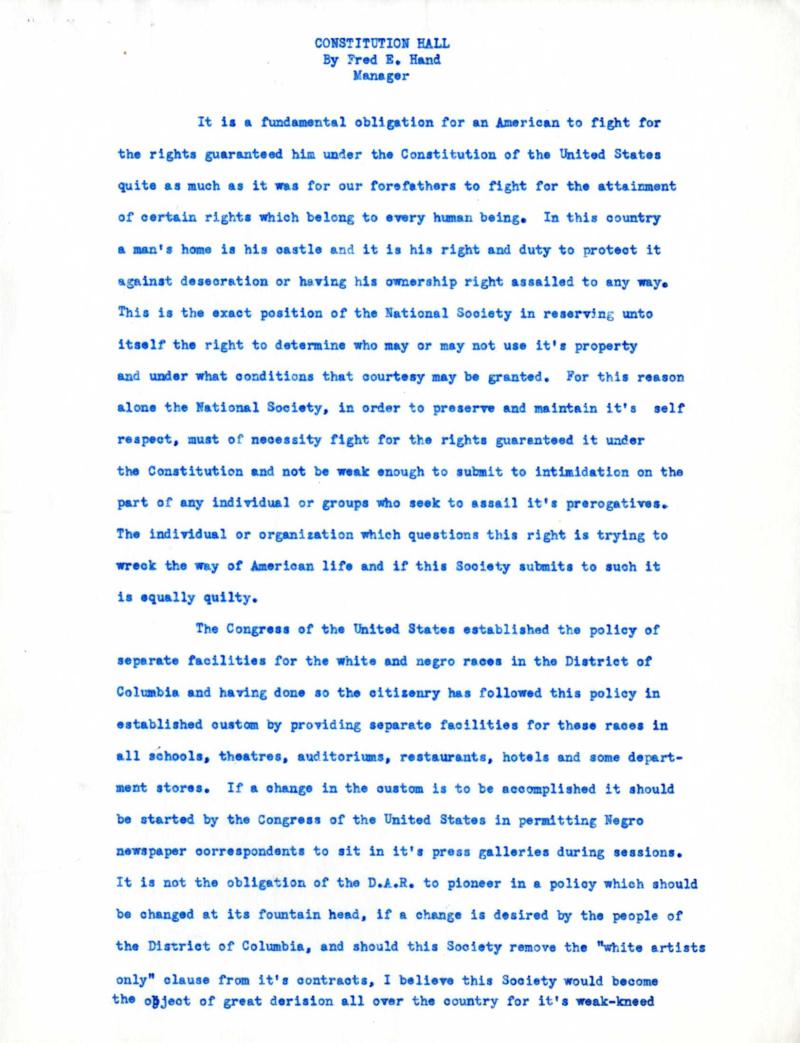
February 1, 1939, NSDAR National Board of Management meeting, verbatim transcript, section related to the Board vote on Constitution Hall policy.
View the section of the transcript
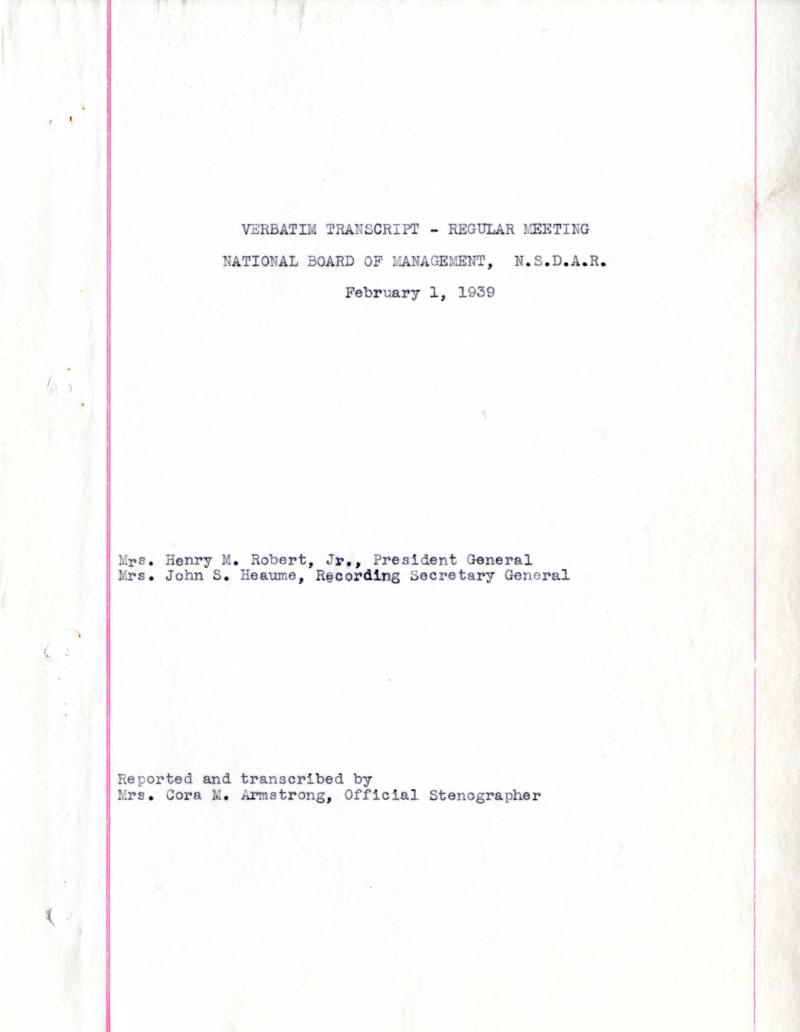
NSDAR Executive Committee Ruling, March 23, 1932, adding the clause “white artists only” to Constitution Hall lease contracts.
1940, prepared statement on the DAR experience with “the racial question,” likely written by Fred Hand, Managing Director of Constitution Hall.
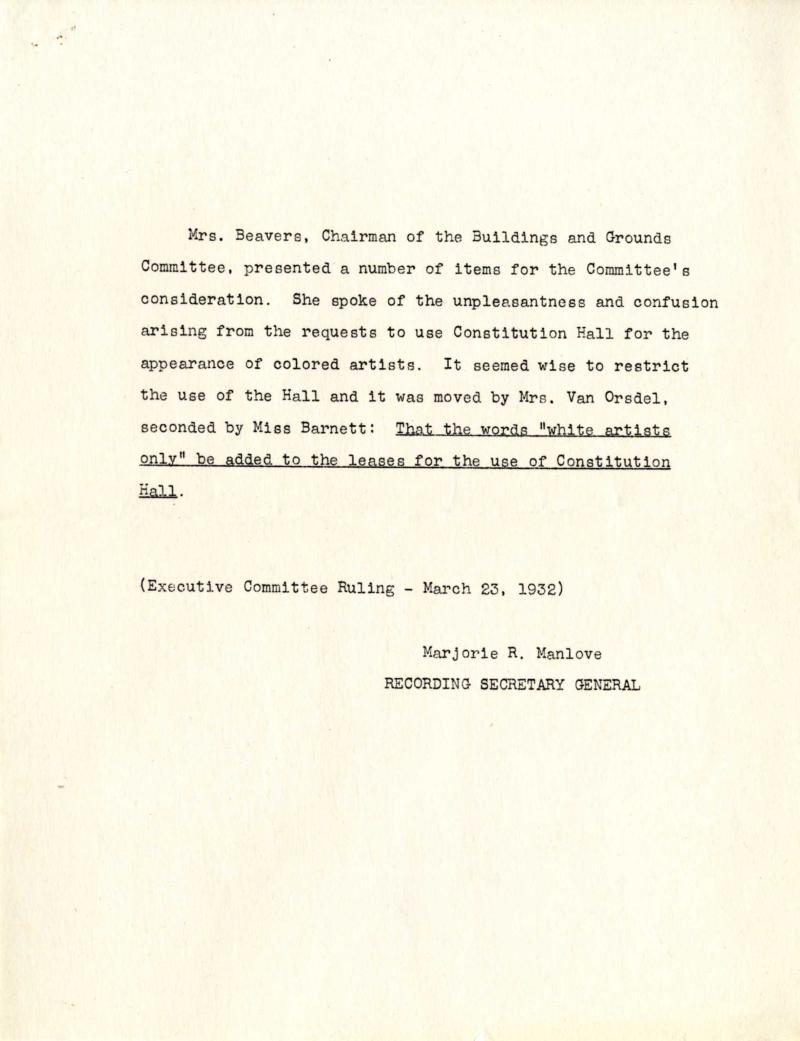
February 8, 1939, copy of a letter from Charles Cohen, Chairman of the Howard University Concert Series, to Fred Hand, Managing Director of Constitution Hall.
February 10, 1939, facsimile of reply letter from Fred Hand to Charles Cohen.
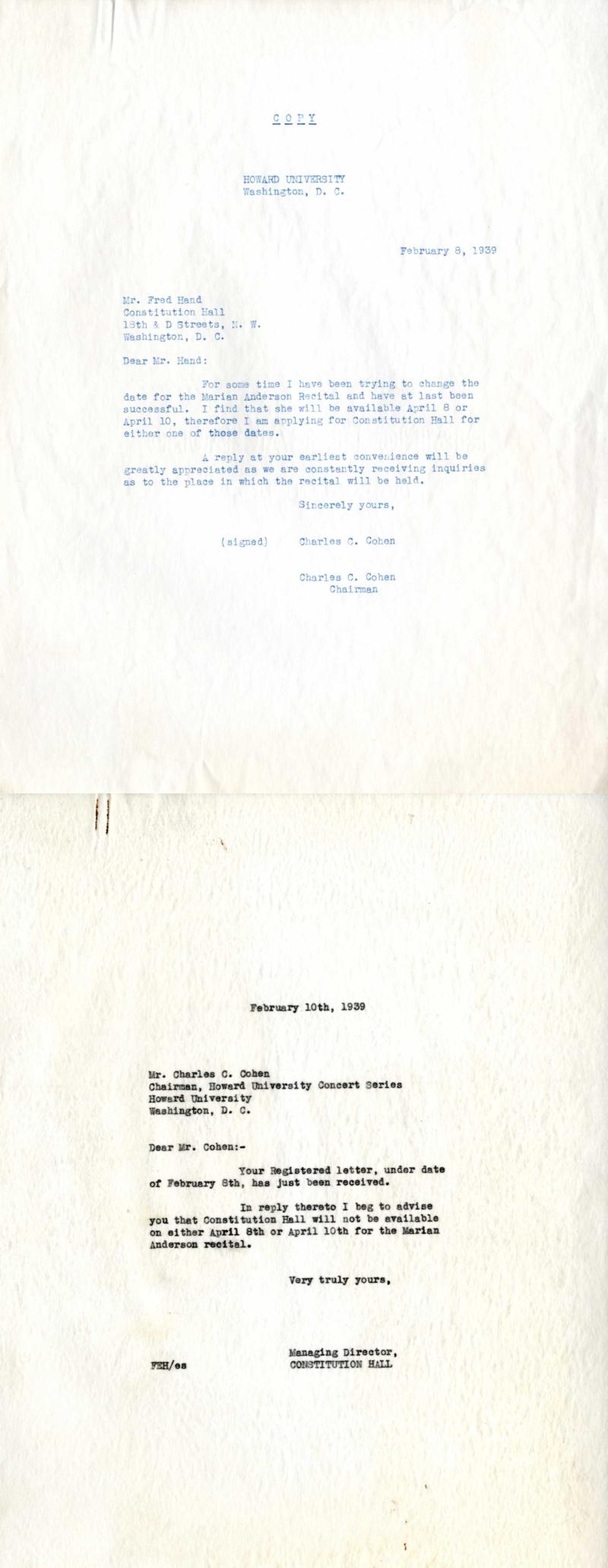
February 13, 1939, circular letter written by DAR President General Sarah Robert to the members of the NSDAR National Board of Management.
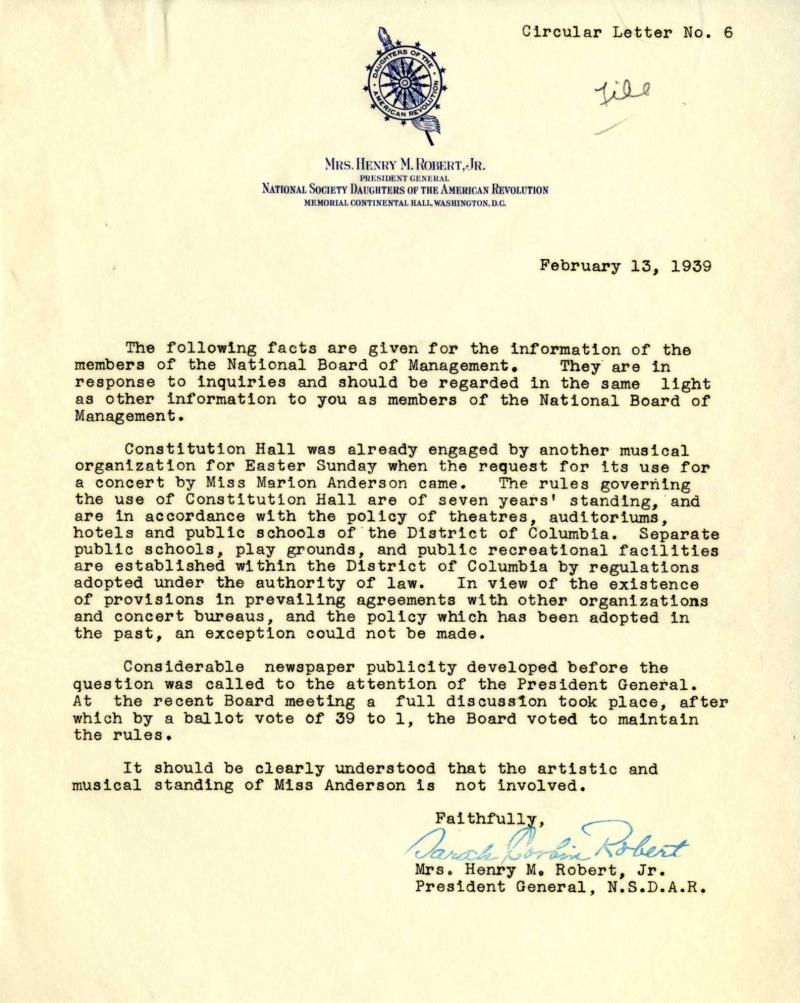
February 16, 1939, letter from Frank F. Nesbit, attorney at law, advising DAR President General Sarah Robert.
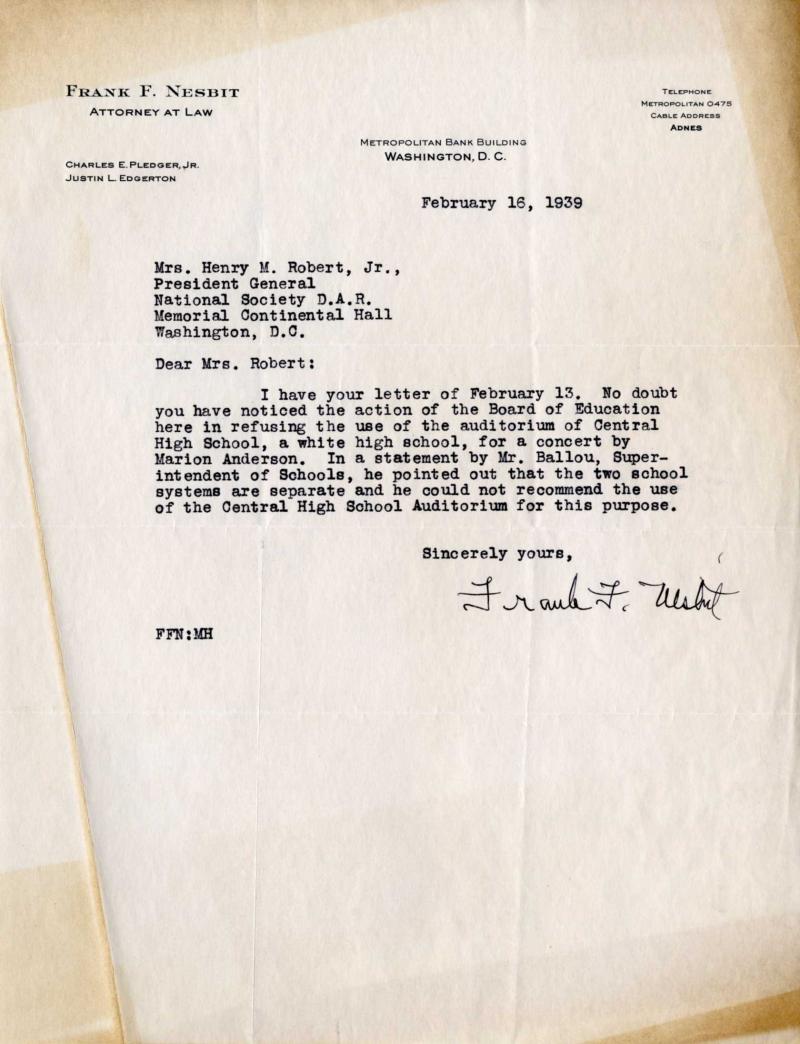
February 23, 1939, letter from Marguerite Schondau, secretary to the DAR President General, to President General Sarah Robert.
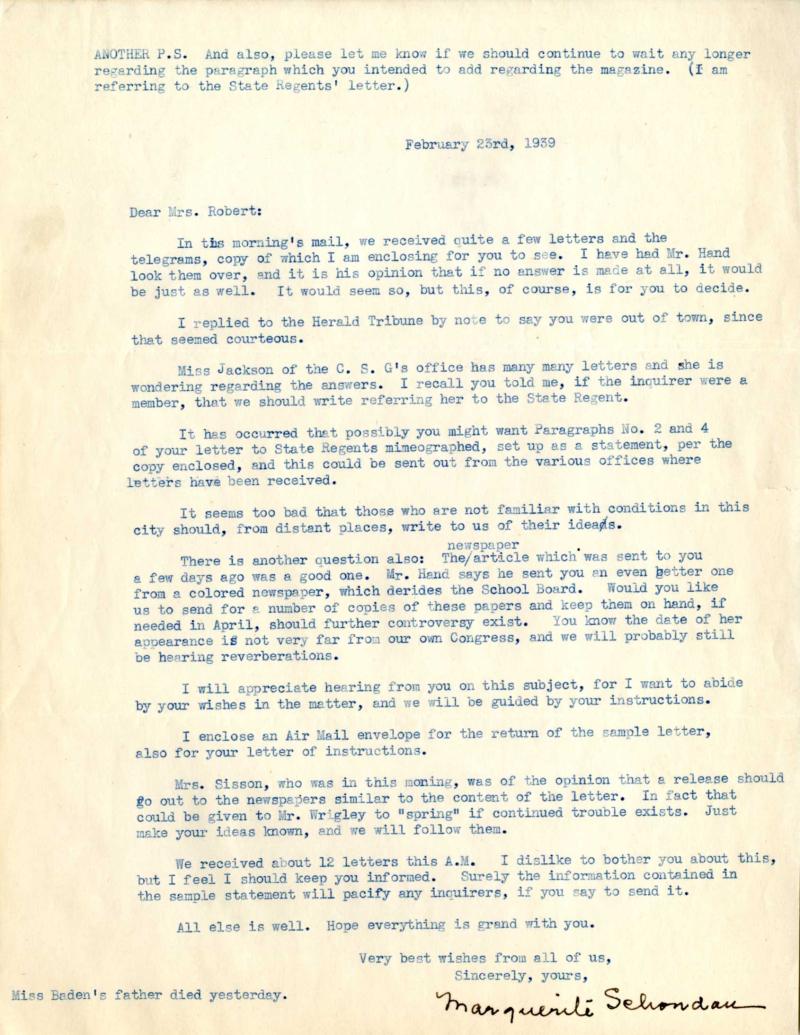
February 26, 1939, First Lady Eleanor Roosevelt’s resignation letter to DAR President General Sarah Robert.
March 4, 1939, President General Sarah Robert’s letter of reply to First Lady Eleanor Roosevelt’s letter of resignation from the National Society.
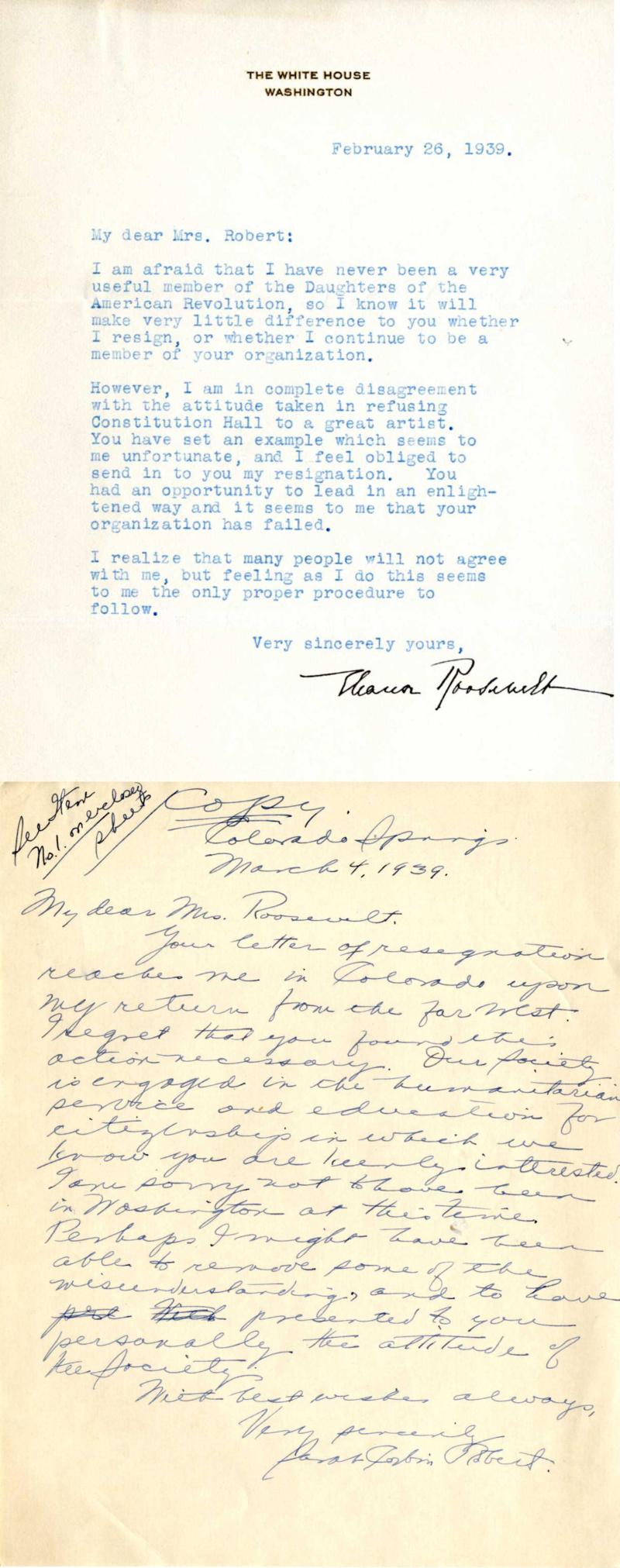
March 1, 1939, Washington Times-Herald, “We Must Hear Marian Anderson: An Editorial.” Article regarding the District of Columbia School Board ruling to deny use of Central High School auditorium for a Marian Anderson concert.
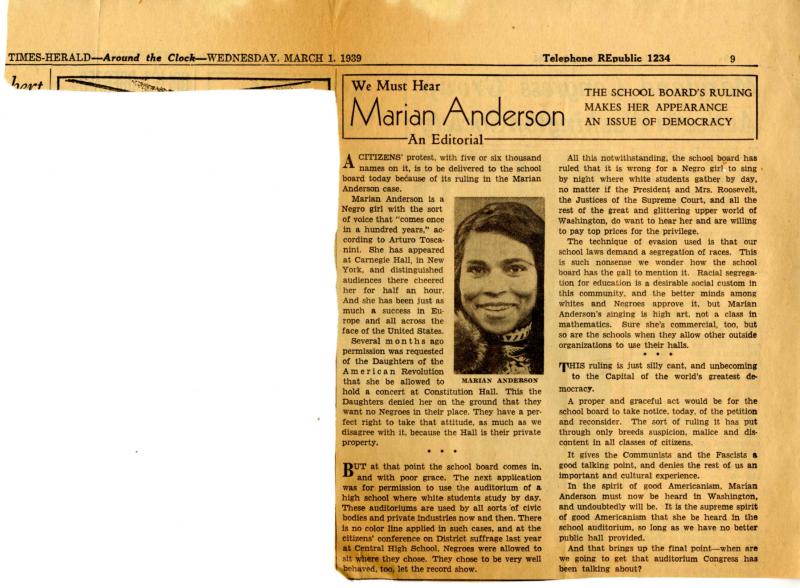
March 1, 1939, letter from Adelaide Sisson, DAR Librarian General, to Marguerite Schondau, secretary to the DAR President General.
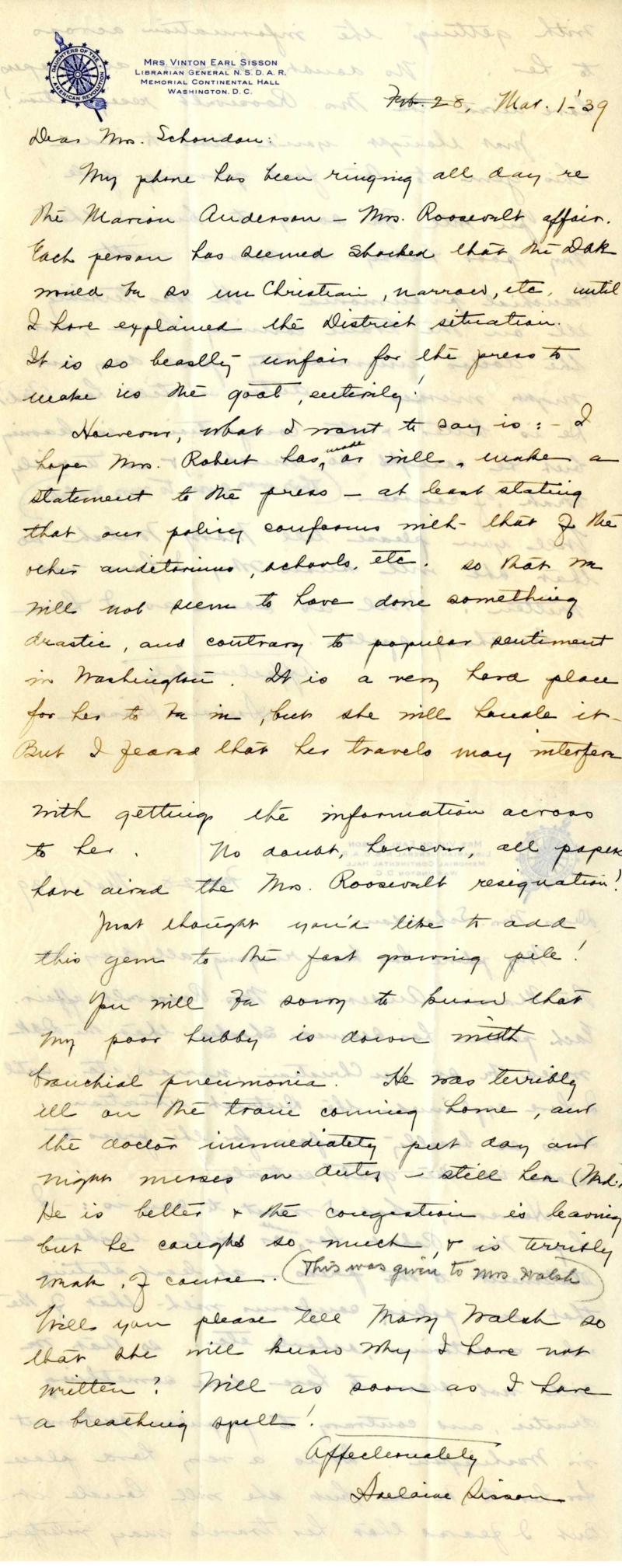
March 1, 1939, letter from Marguerite Schondau, secretary to the President General, to DAR President General Sarah Robert.
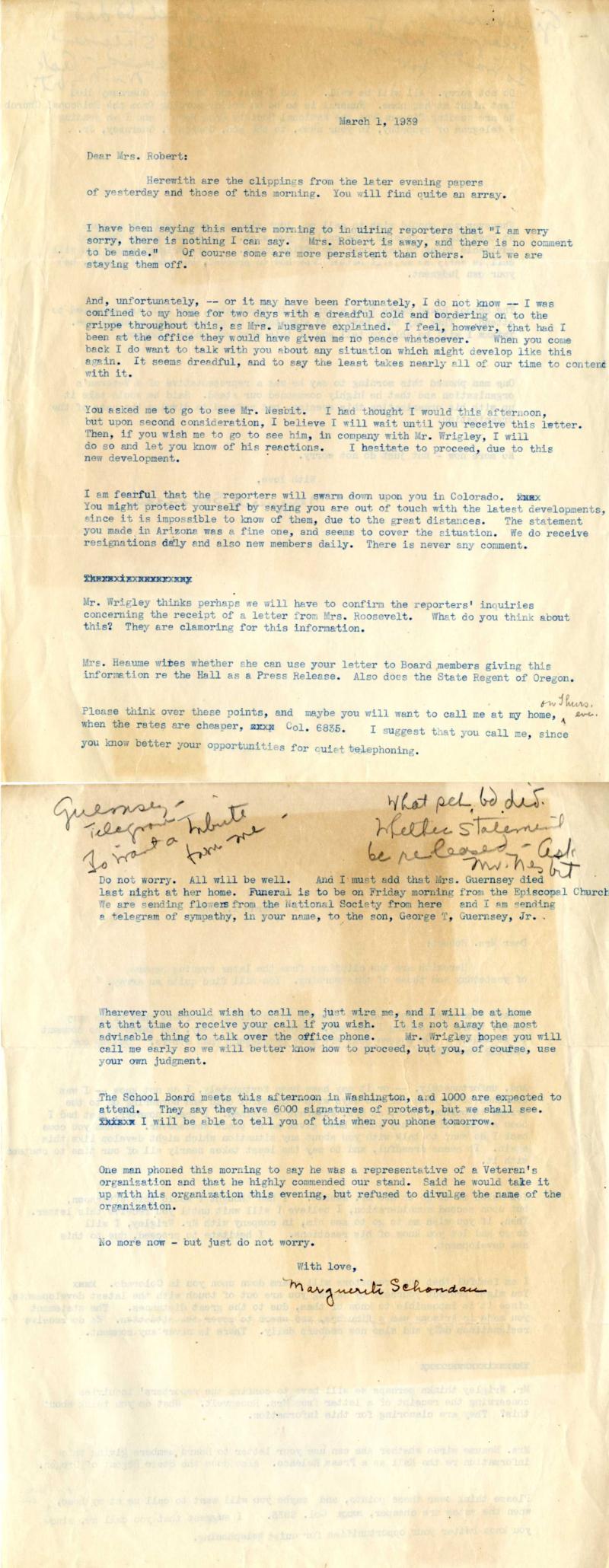
March 2, 1939, letter from Adelaide Sisson, DAR Librarian General, to Marguerite Schondau, secretary to the President General.

March 3, 1939, letter from Belle Nason, DAR Registrar General, to DAR President General Sarah Robert.
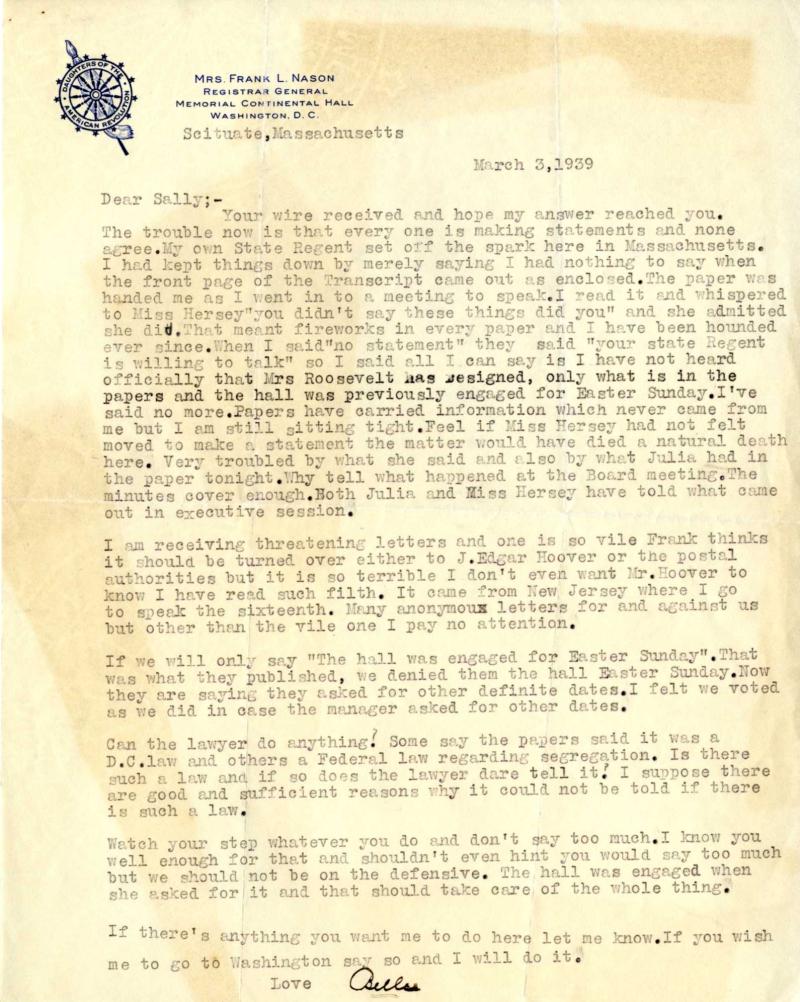
March 3, 1939, Margaret Schondau, secretary to the DAR President General, to President General Sarah Robert.
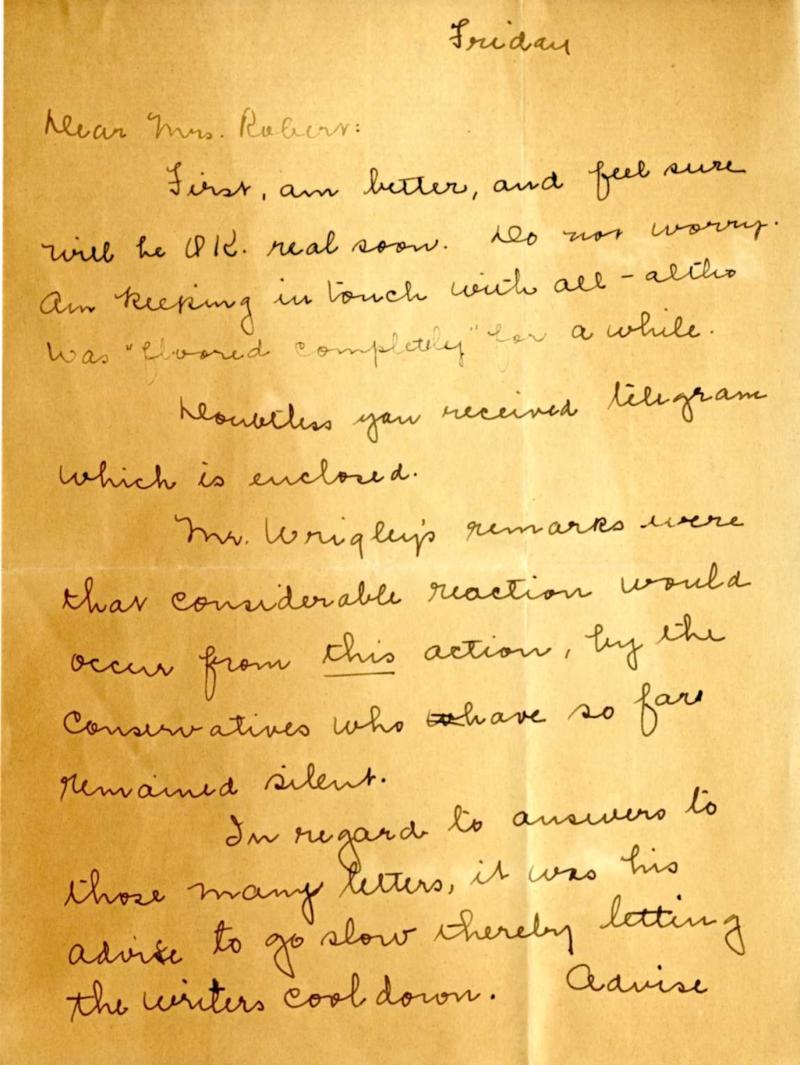
March 3, 1939, Letter from Fred E. Hand, Managing Director of Constitution Hall, to DAR President General Sarah Robert, with copy of a letter from Mary C. Nelson to Dorothy Hodgkin Dorsey, Washington Concert Manager, dated March 1, 1939.
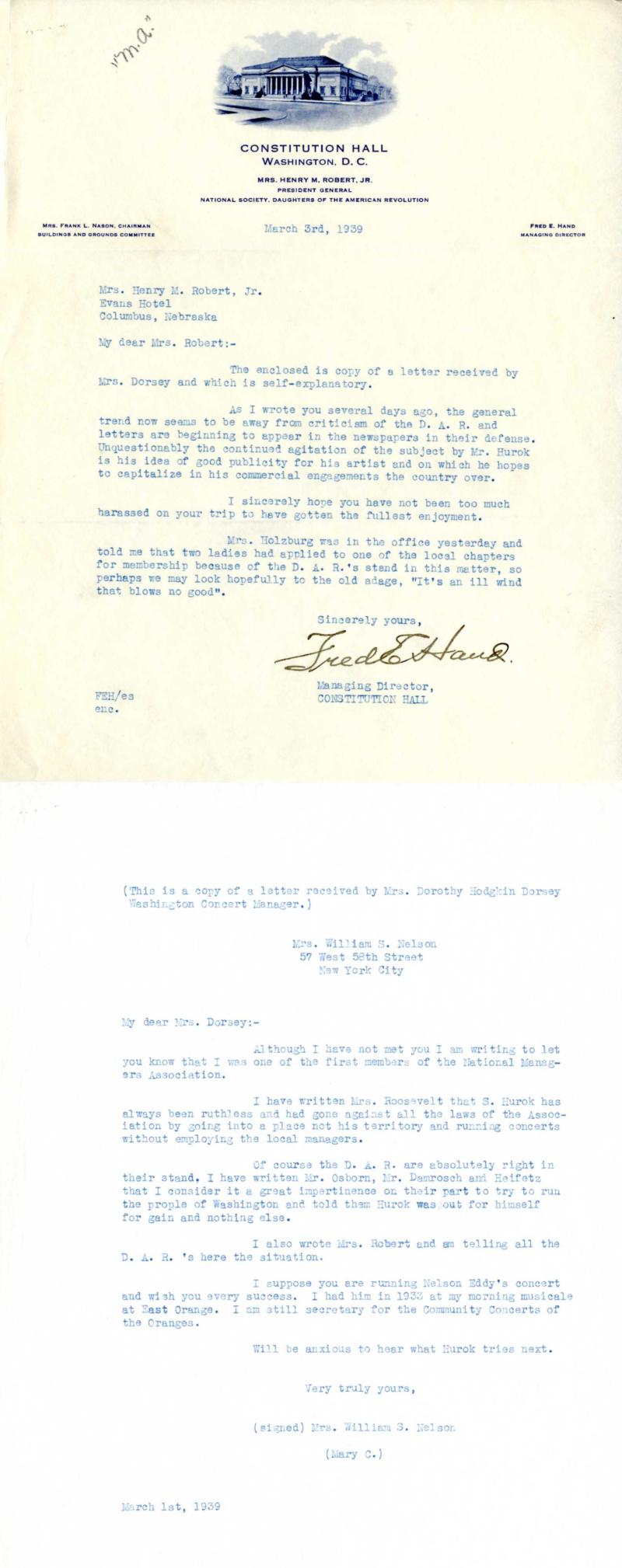
March 3 & 4, 1939, letters from Tom Wrigley, of Lewis and Wrigley Publicity, to DAR President General Sarah Robert.
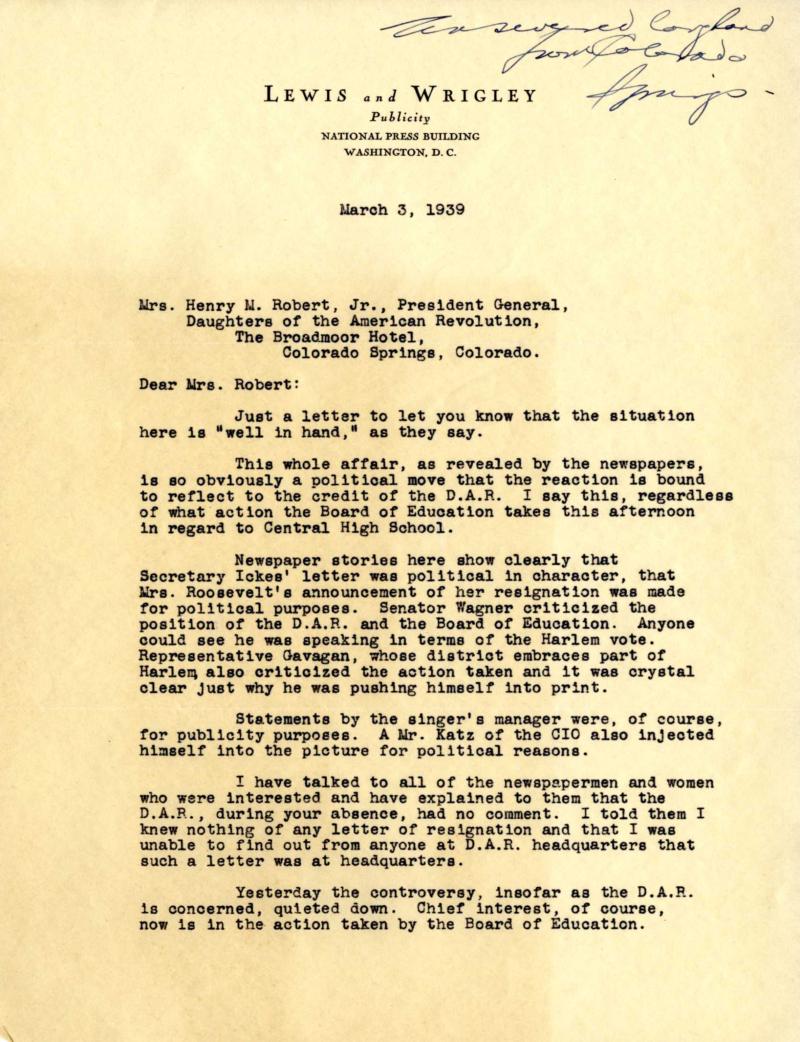
March 5, 1939, letter from DAR member Anna Richards to DAR President General Sarah Robert.
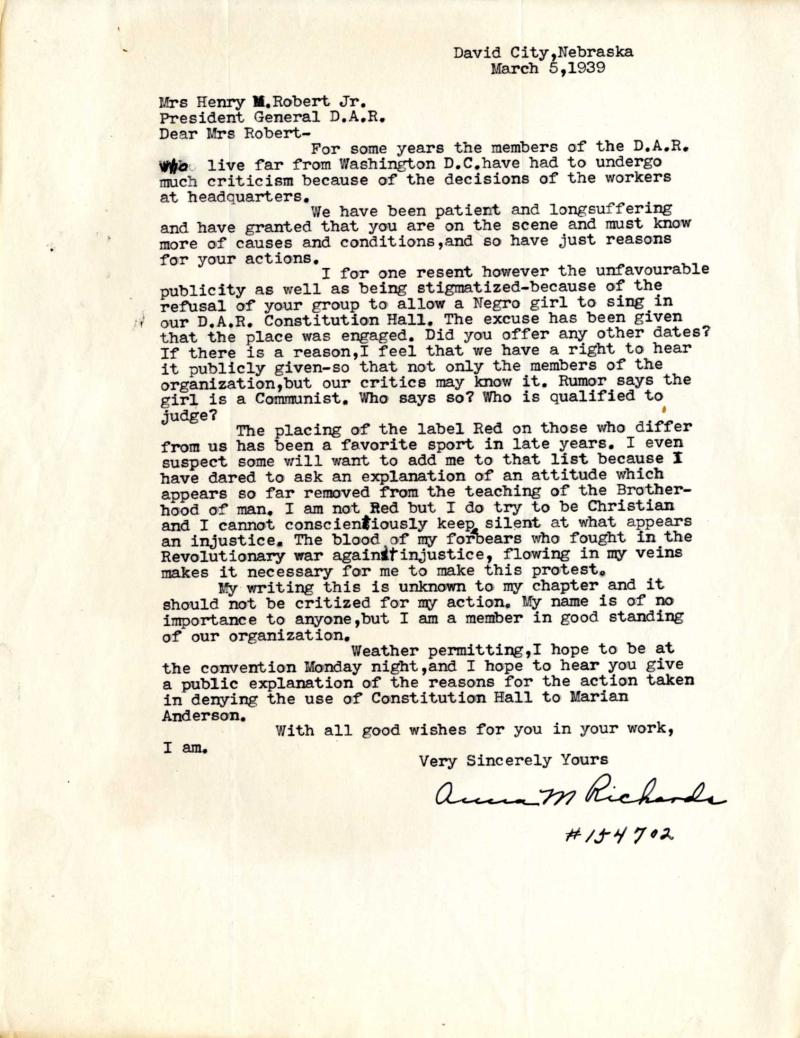
March 8, 1939, letter from Marguerite Schondau, secretary to the DAR President General, to President General Sarah Robert, including letters with Adelaide Sisson and the newspaper Chicago Herald & Examiner.
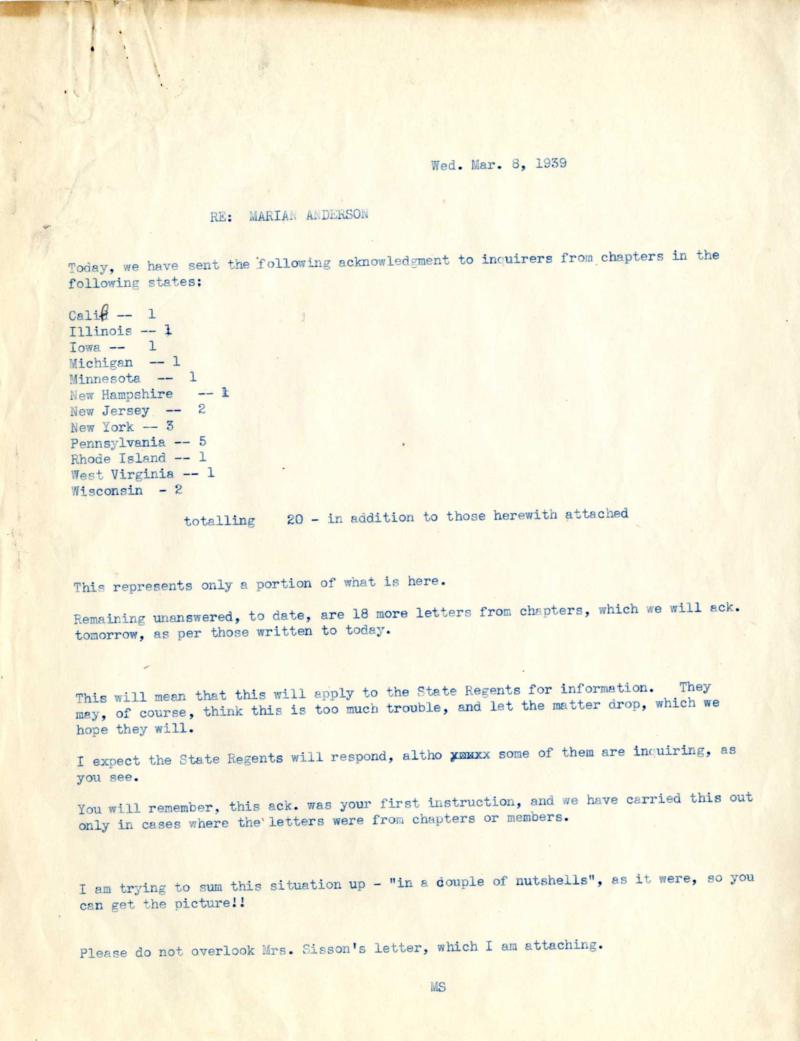
March 11, 1939, letter from Reverend Anson Phelps Stokes to DAR President General Sarah Robert.
March 20, 1939, facsimile of reply letter from Marguerite Schondau, secretary to the DAR President General, to Reverend Stokes.
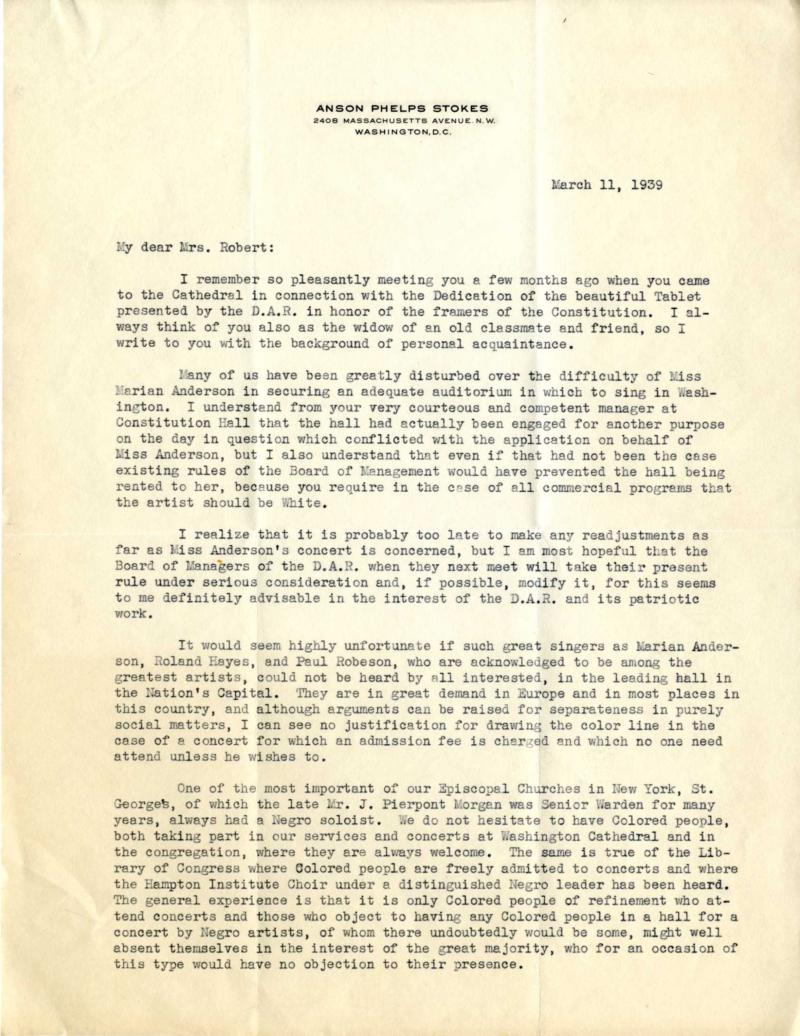
March 14, 1939, letter from DAR member May Whitney to DAR President General Sarah Robert.
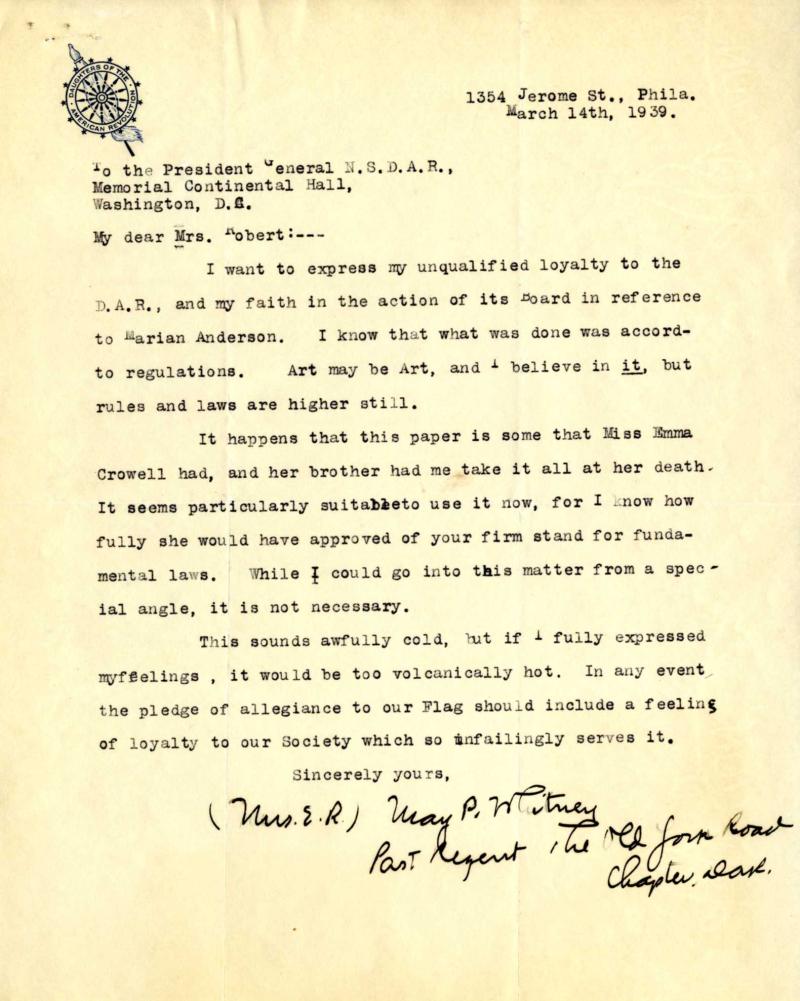
March 15, 1939, letter from George Musgrave, attorney at law and husband of DAR member Anne Musgrave, to DAR President General Sarah Robert.
April 11, 1939, facsimile of reply letter from Sarah Robert to George Musgrave.
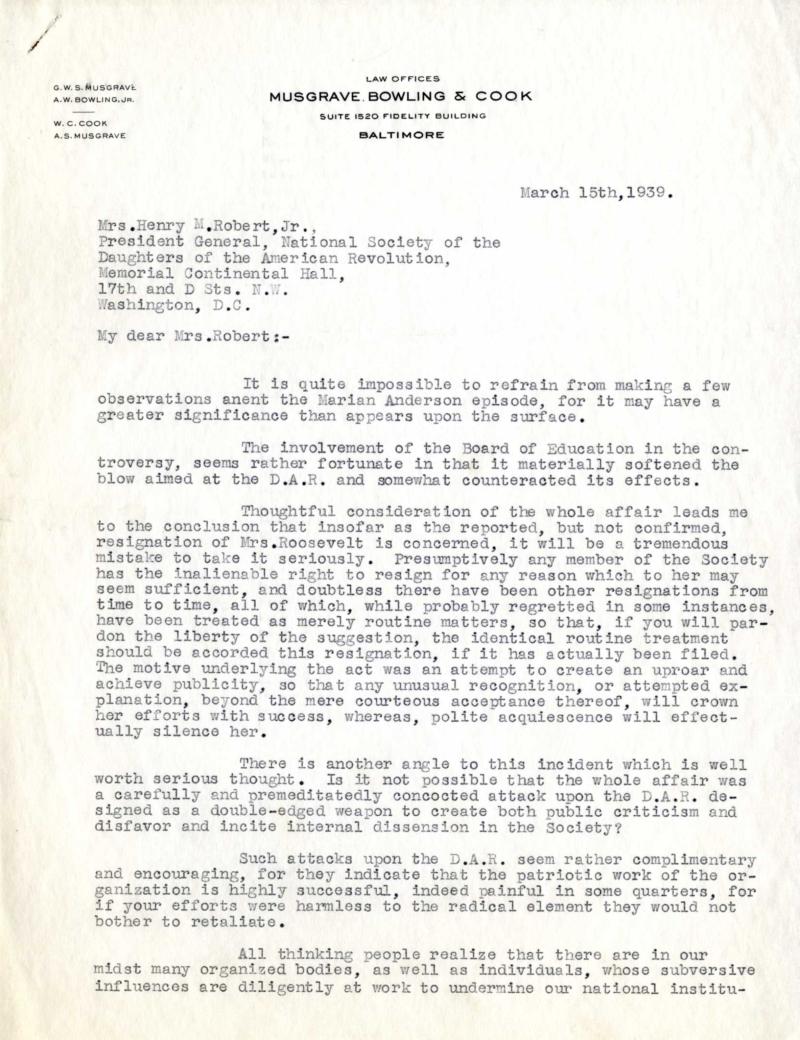
March 16, 1939, letter from Marguerite Schondau, secretary to the DAR President General, to President General Sarah Robert.
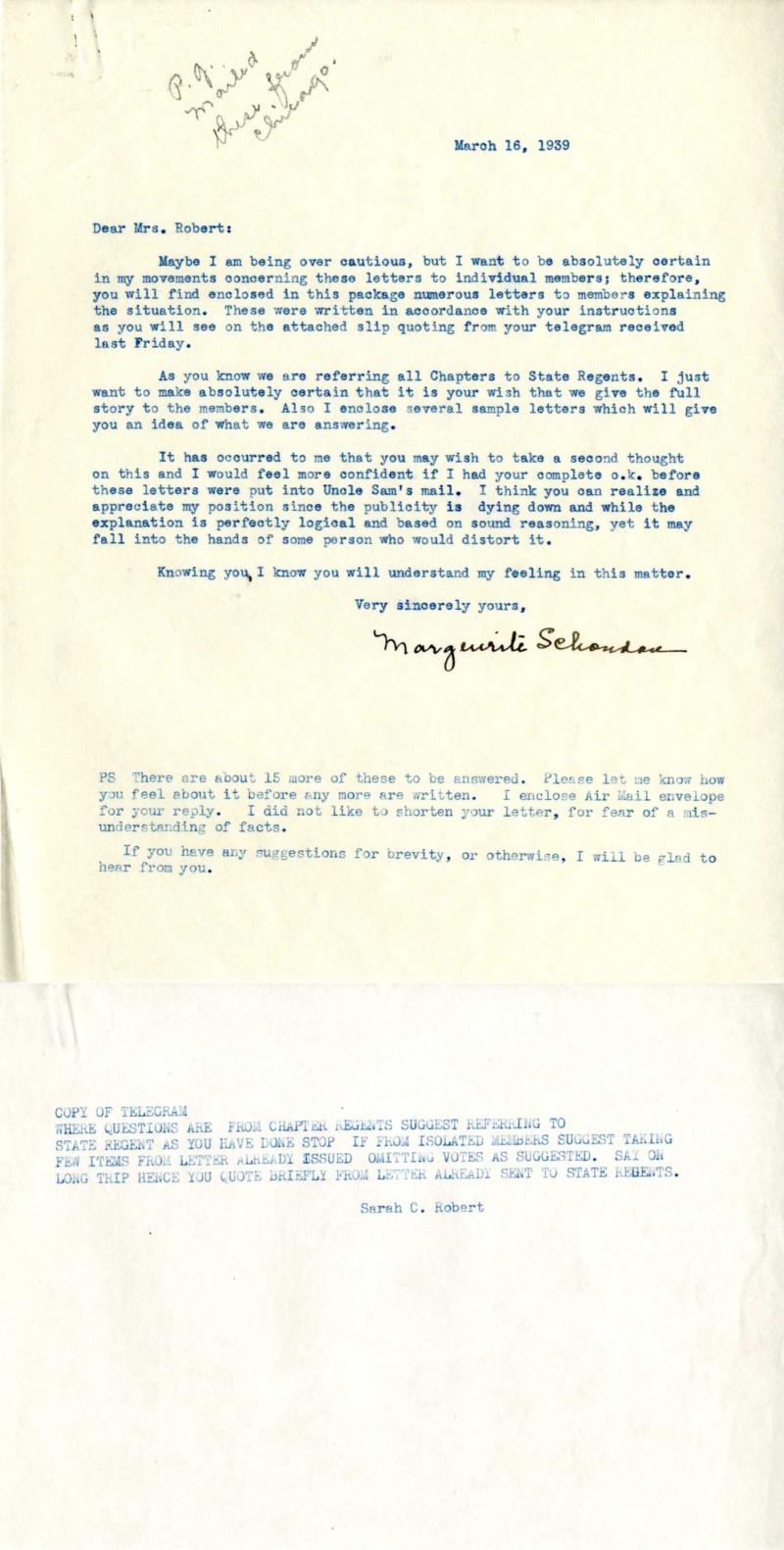
March 16, 1939, letter from DAR member Amy Perkins to DAR Honorary President General Florence Becker.
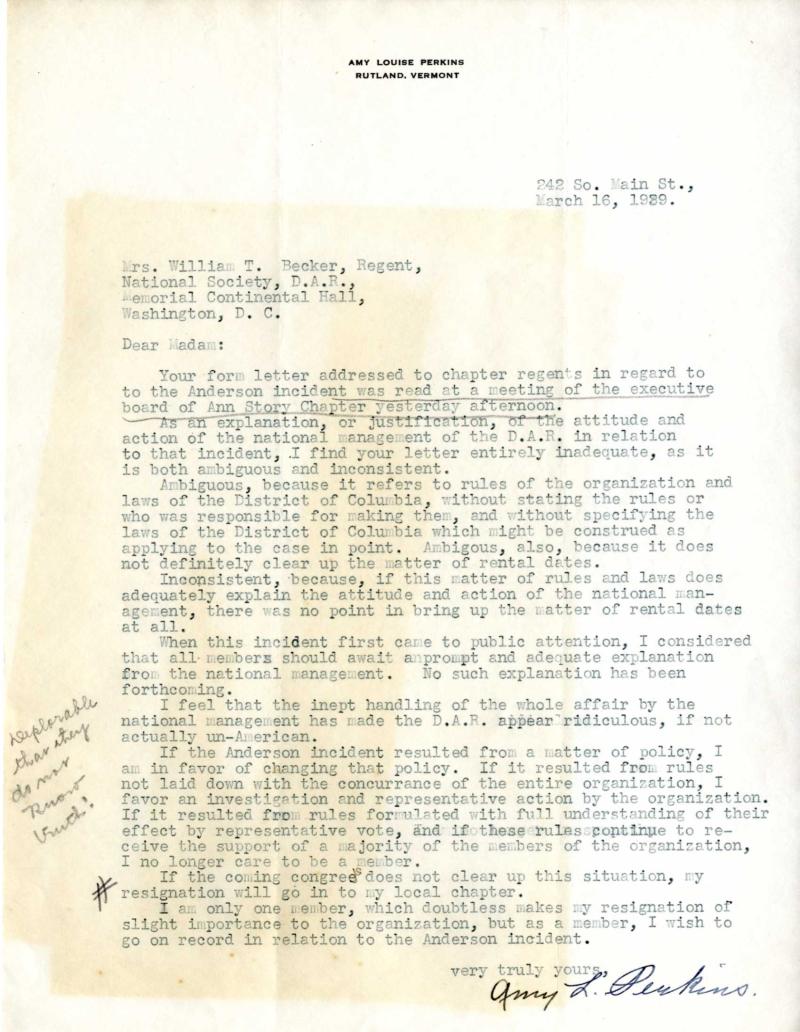
March 18, 1939, letter from Senator Ernest W. Gibson to DAR President General Sarah Robert.
March 22 1939, facsimile of reply letter from Marguerite Schondau, secretary to the DAR President General, to Senator Ernest W. Gibson.

March 20, 1939, letter from Page Schwarzwaelder, DAR Treasurer General, to Marguerite Schondau, secretary to the DAR President General.
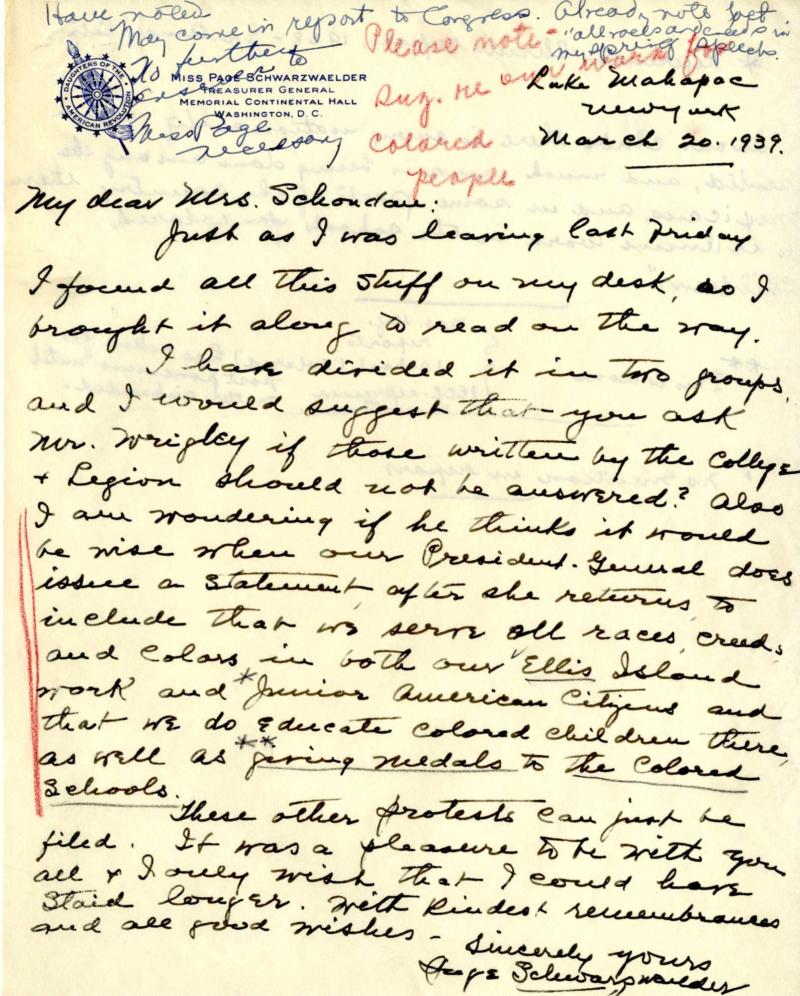
March 1939, letter from DAR member Clara Hill to DAR President General Sarah Robert.
March 25, 1939, facsimile of reply letter from Marguerite Schondau, secretary to the DAR President General, to Clara Hill.
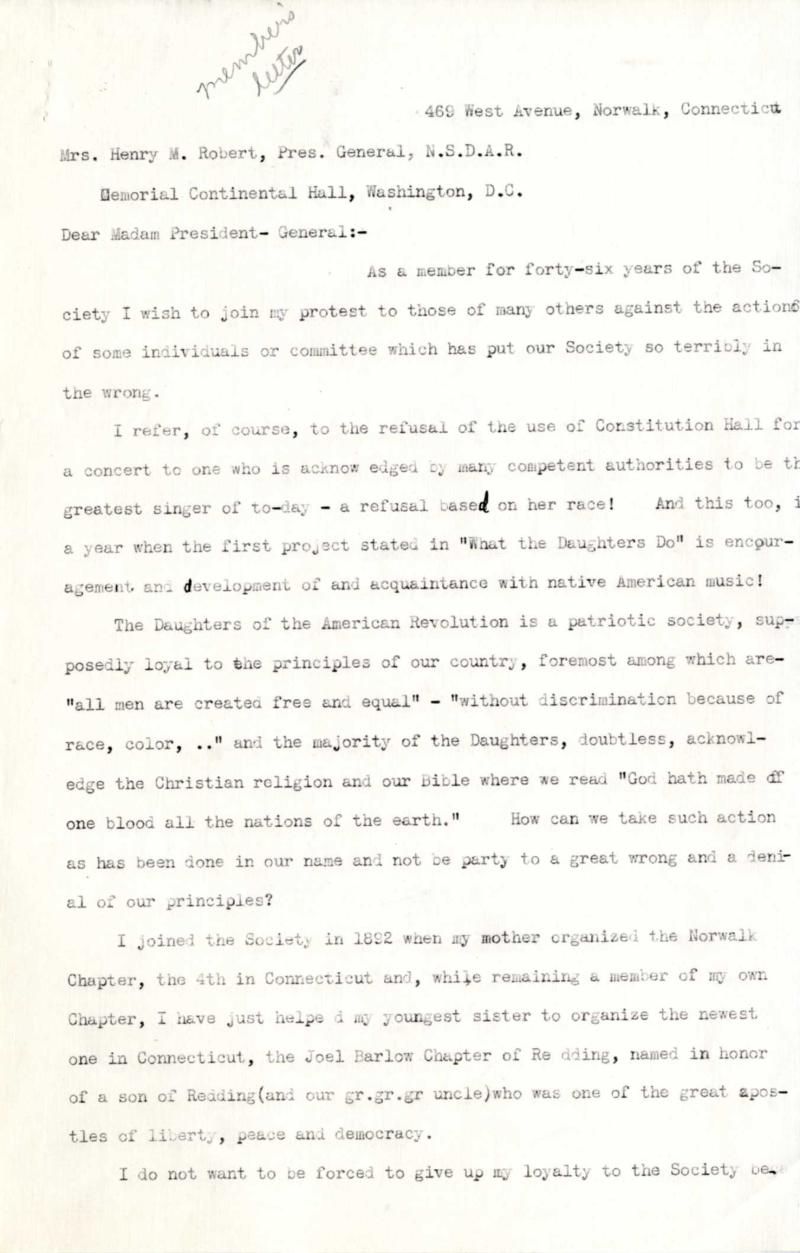
April 10, 1939, Washington Post article (image from the Washington Post Online Archives) covering Marian Anderson’s Lincoln Memorial concert on Easter Sunday. “Marian Anderson stood on the steps of the Lincoln Memorial yesterday, sent her matchless contralto voice out over the air and held a crowd of 75,000 enthralled. Born of an angry controversy, the open-air concert ended in an atmosphere of exaltation, as the crowd roared its acclaim for the colored girl whom “genius touched with the tip of her wing.””
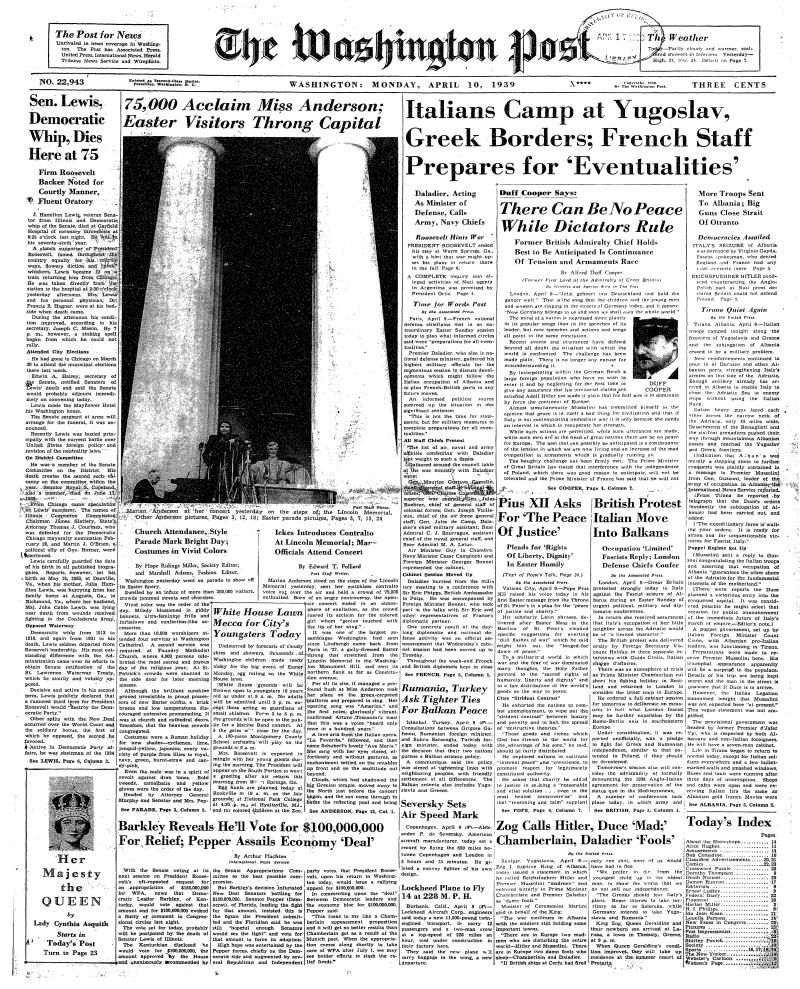
April 11, 1939, letter from Representative Arthur Mitchell to DAR President General Sarah Robert.
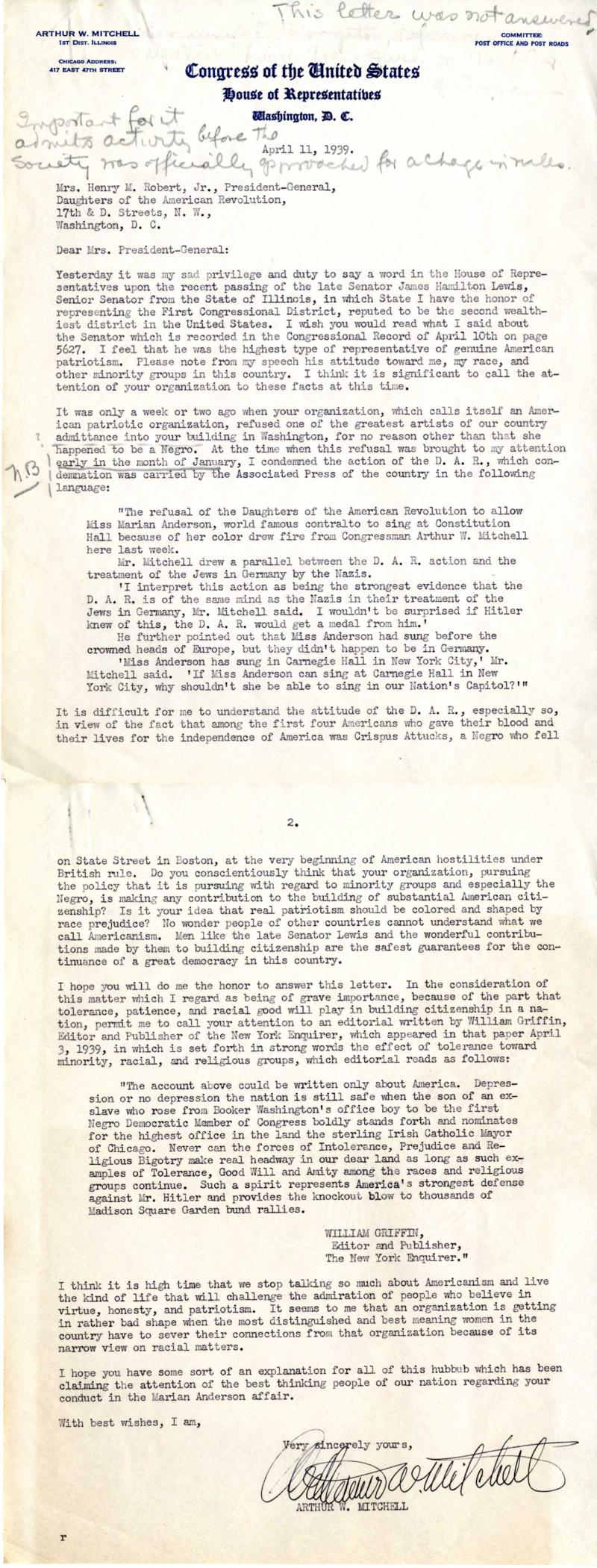
April 15, 1939, letter from Walter White, NAACP Secretary, to DAR President General Sarah Robert.
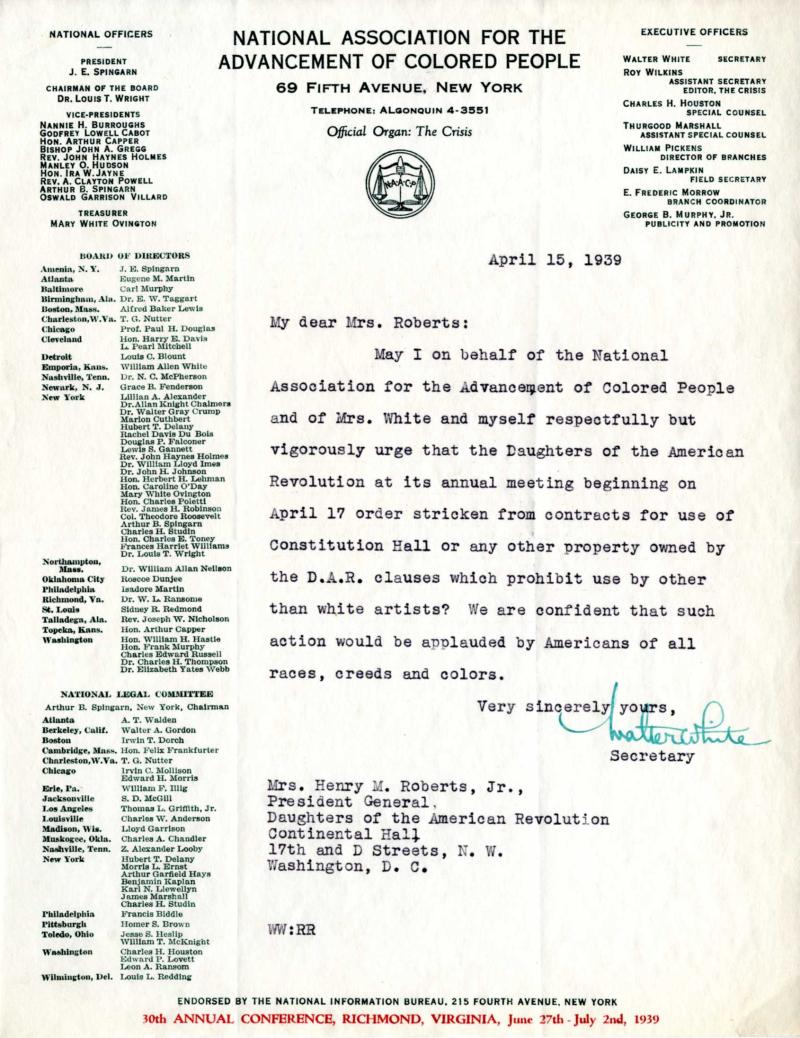
April 17, 1939, Excerpt from the Report of the President General Sarah Robert (Mrs. Henry M. Robert, Jr.), 48th Continental Congress, the annual convention of the Daughters of the American Revolution. This is the portion from Sarah Robert’s full report at the DAR Continental Congress that references the Marian Anderson issue. The excerpt was printed in a booklet (as shown) and used to send as explanation when anyone would write to the National Society about the Marian Anderson incident. In addition to the President General excerpt, the standard response would also often include a copy of the Washington Post article “Aftermath” (next slide).
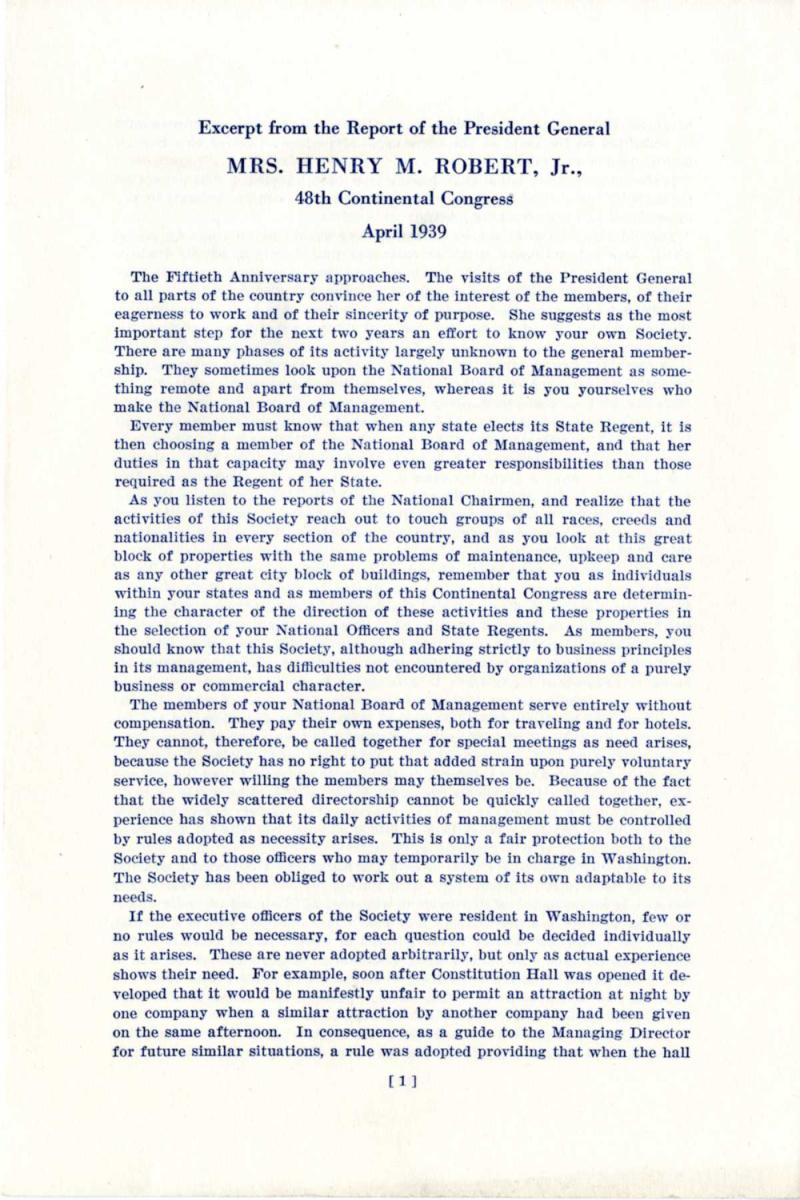

April 26, 1939, letter from Frank F. Nesbit, attorney at law, advising DAR President General Sarah Robert.
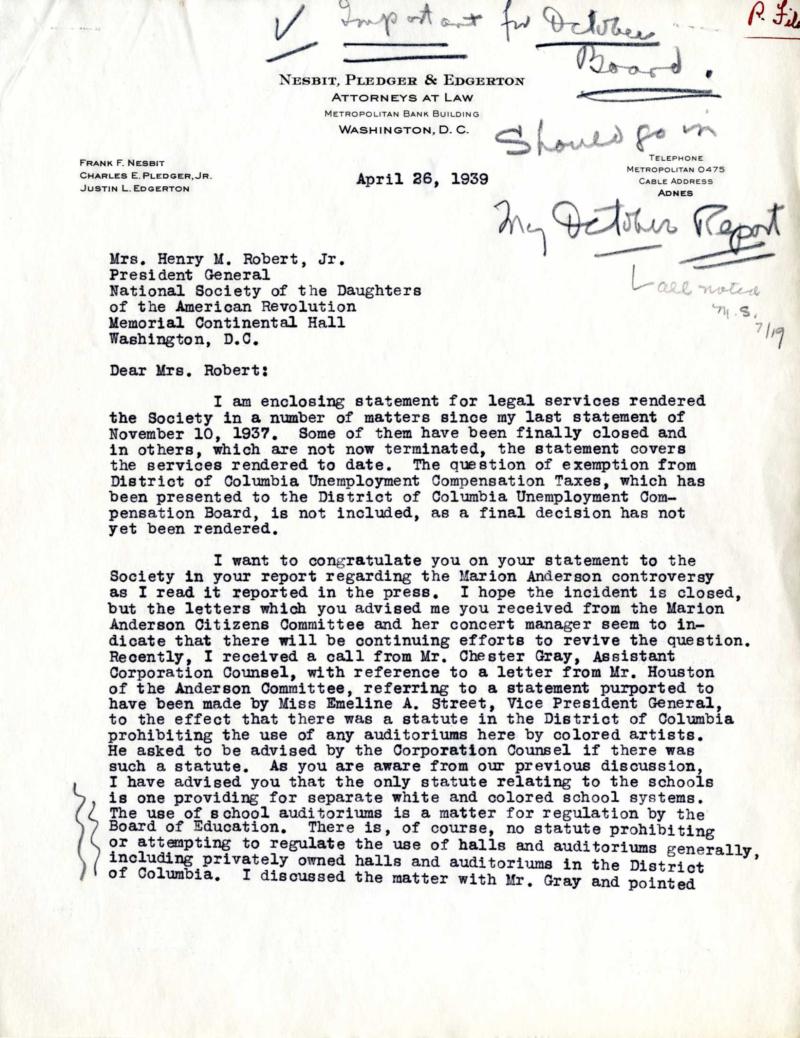
The events and publicity surrounding Marian Anderson’s concert at the Lincoln Memorial helped to highlight the underlying issues and conversations surrounding race in America. In 1939, that conversation had yet to develop into the Civil Rights Movement, which took place almost 25 years later. Because of this, Marian Anderson is often regarded as a pioneer in the fight for racial equality.
The opinions and issues put on display surrounding the denial of Marian Anderson to perform in Constitution Hall helped to sow the seeds of change not only within the DAR, but throughout the country; although history shows that change often does not occur immediately. In 1942, the Daughters of the American Revolution invited Marian Anderson to sing in Constitution Hall for a war relief concert on January 7, 1943. It was followed by years of discussion and internal campaigning by DAR members, who succeeded in their endeavors in 1953, when the DAR ended its “white artists only” policy in Constitution Hall. Following this change, Marian Anderson performed numerous times in DAR Constitution Hall, even choosing the venue in 1964 to launch her farewell tour.
The NSDAR Archives Marian Anderson Subject Guide will be announced upon completion, and made available on the Marian Anderson Resources page on the DAR website.
